#specifically in the context of existing inside a video game no less!!!
Explore tagged Tumblr posts
Text
angel hare is peak btw. after yesterday’s episode (disc 5) i fear that, depending on how things develop in the next one, i may have a new blorbo
#angel hare#(vague spoilers in tags)#it’s the character who’s taken on the weight of the world for the sake of a dangerously codependent relationship#where they think keeping the other party mentally trapped in a version of childhood/adolescence is what will keep them safe#and has become so absorbed in their role as to not know how to exist and conceive of concepts outside of its boundaries for me#specifically in the context of existing inside a video game no less!!!#(also they’re nonbinary. it’s like they were made for me)#stellar voice acting from The Character in this ep btw. in terms of both range and pure emotionality
13 notes
·
View notes
Text
tutelary magic
something i've been encountering a bit lately is an anthropological lens on magical practice. I think the field suffers from western bias in many ways, and one of them is shuffling anything that involves sincere belief in the supernatural into a box labeled "religion". so i'm going to talk about tutelary magic for a bit. for starters, what is magic? magic is a way of effecting results in the world. it overlaps with superstition: things that are known to work, even if the explanation is scientifically wanting. a video i watched recently discussed magical behavior in baseball, and noted that it was most prevalent in parts of the game where luck dictates outcomes to an outsized degree - pitching, say - and less prevalent in parts of the game dictated by skill. even a non-superstitious pitcher believes in stuff like being "psyched out" in a way that wouldn't make sense for a shortstop - you catch and throw the ball or you don't, whereas pitching is much more nebulous in its play-by-play results.
anyway! i would define tutelary magic as a system of magical behavior where effect is sought, either in the actor or the world or both, with the assistance of a supernatural agent. the supernatural agent is generally located both inside and outside of the self. systems of tutelary magic you might be familiar with are folk catholic saints, spirit animals, and (slightly silly example) stands in Jojo's Bizarre Adventure.
three things leap out at me about this: 1. the freudian unconscious is tutelary magic, and possibly the most dominant form of tutelary magic in the west. The unconscious self acts outside of the agency of the actor, effecting results in the body. When westerners reach for a rationalistic explanation of tutelary magic in other cultures, they almost invariably resort to the Freudian unconscious, even if they do not subscribe to the Freudian trinity of id/ego/superego or any other features of Freud's theory of the unconscious. turn the lens backwards: the unconscious is a prominent western way of describing the extremely commonplace use of agents external to the self to effect the self. it is as culturally specific and magical in origin as a prayer to St. Christopher, a whisper from the devil on your shoulder, or activating Star Platinum to beat a guy up.
2. the DID umbrella has implications here; it strikes me as a way for westerners to reapproach the idea of agents who exist both inside and outside of the self, after centuries of subscribing to an extremely solitary and isolated self-concept. this is not to deride people with alters or kintypes or what have you, but it's to say that they're part of a wider context that is nearly ubiquitous in humanity.
3. belief is important to any magical system "working", but plays an unusually subdued role in tutelary magic. in all of these magical systems, believing in an external+internal other as an agent is unnecessary to be acted on by that agent, or to have that agent incorporate you into its actions. circling back to the unconscious, again, even people who do not especially put stock in Freud will resort to unconscious behavior as explanations for things all the time, even things they themselves do. "it's real to me" is close enough to something being real for government work, and certainly close enough to make a difference to the body, and sometimes to the world outside of you. (what happens when you grip a pot full of broth weakly because you're in a bad mood and it falls on the floor? does your carpet care that you think you're in complete control of your body, so you should have been able to prevent that? does it become more or less dirty as a result?)
28 notes
·
View notes
Photo

my mind looks a lot like a_: a Video Game Playlist
Whether in an abandoned mall or an opulent estate, this playlist is all about embarking on a surreal architectural journey of the psyche. Investigate and explore these vaporwave-influended spaces, witness two speculations on technology of the future, and interrogate your digital reality. It’s Holovista’s mega-mansion house tour internship and the liminal awakening personality profile of Self-Checkout: Unlimited – step on inside.

Holovista
Previously covered, Holovista follows Carmen Razo on her newly acquired and direly needed job working for the innovative high class architectural firm Mesmer & Braid. The first task given to her, however, is a strange one – a field assignment to inhabit the firm’s mysterious new project, the autohaus, and to document her experiences by relaying them to her not-Instagram following. In game, this is achieved by taking photos of a number of requested items in a 360˚ scene, and then match appropriate photos to a caption in order to post them, chatting with your friends over DM (and whatever intern is running the Mesmer & Braid account) along the way. The latter gets only more important, as the autohaus’s design, and Carmen’s own mental state, gets more questionable as her residence goes on.
Fine attention to detail in order to spark immersion is the real crux of Holovista – the rendered scenes that you experience strike a delicate balance between striking realistic fidelity and the dreamlike opulence of the game’s low Sci-Fi future. The environments (at least, the non-creepy ones) are something you’d want to just exist in, partially because they feel so believable and possible. The Social Media interface has comments on every post, and profiles for every commenter, and most important of all, top notch Internet writing. Everybody talks like actual internet users, and several conversations between Carmen and her friends that could have come out of me and my friends. Even the basic gameplay loop puts you directly in Carmen’s shoes – you turn around (or swipe on your screen) to take photos of stuff and then post them just as she does.
This immersion is all put to good use in the story itself then, which reflects that immersion back (though I’ll not elaborate, to avoid spoilers), culminating in a game that’s not really like anything else I’ve ever played.
Specifications
iPhone
$4.99
~2 hrs

Self-Checkout: Unlimited
Self-Checkout: Unlimited, on the other hand, hits upon the environment of slightly oldish an abandoned mall. Starting out with a horror-esque tone as the player character finds themselves in a barely lit hall on a bench, forced to navigate a store housing a terribly unnerving teddy bear before the mall opens up, you are then invited via disembodied intercom to explore various sections and stores of the mall, all with… unusual set-ups focused on psychology. Between children’s rides based off of a fictitious children’s show structured around personality profiles and a clothing store rack with jackets labelled with things like ‘parents’, ‘significant other’, and ‘friends’ on a scale from most to least important, the mall is less a real space to engage in commerce and more a loci for an examination of the self. The surreality is only increased in scenes when the mall fades away in favor of environments with strong vaporwave aesthetics often reflecting other elements of commerce all whilst the interrogation of the self continues on, like a Psych 101 professor giving a lecture over a lo-fi, echoic beat.
Compared to the DM conversations between friends in Holovista, the only form of communication is always faceless – either via seemingly pre-recorded intercom announcements, or by a narrator seemingly talking both to the player character and the player themselves. As the mall is explored further, the unique specifics of the self-examination build towards the context of the mall’s liminality – which I’ll hold back in face of spoilers. The details towards this context are thought-through, perhaps to the point of maybe giving the game away, but in the end it’s a cohesive build that helps take the weight of the philosophizing off a bit.
Specifications
Windows, Mac, Linux
$7.99
~1.5 hrs
Sum Specifications
iOS & Windows/Mac/Linux
$12.98
~3.5 hrs
#Talkin' 'Bout Tiny Games#Video Games#Indie#Holovista#Self-Checkout: Unlimited#Under 5 dollars#Under 10 dollars#Under 20 dollars#Under 5 hours#iOS#Mac#Windows#Linux
4 notes
·
View notes
Text
RWBY Volume 8 Chapter 7 Review/Remix
Last episode before the holiday break. The long long long holiday break. And here I am only posting my review the night before we come back... I was having a lot of fun playing my new video games, okay? Let’s just get right into this with the joke everyone has already made. War: What is it good for? Actually a lot, if you can believe it. Only in this specific context though, because the warfare in the American streets these last few days is disgusting and emblematic of what has been wrong with the country for a while. A government leader sending his followers into the nation’s capital on a mission of rage and personal catharsis? Ick. At least in RWBY the tyrant isn’t attacking members of his own population... Oh wait, Mantle. :P
For a moment you might be fooled into thinking we’re starting back in the farmlands of Mistral, maybe getting another look at Oscar’s earlier life or seeing a little more of Nora’s mysteriously tragic past before she and Ren met. But no, these are the wheat farms on the outskirts of Atlas and Sabyrs are charging through like raptors through the tall grass in Lost World. A battalion of Atlesian soldiers, human soldiers I might add, stand armed to meet them. But even if they’re armed they are by no means ready. Monstra keeps coughing up a new wave of Grimm, and I do mean a wave, every minute or two and Atlas is pretty damn whelmed in the face of it. There are some big bots with guns standing in straight lines, but the majority of the defense put up by Remnant’s supreme authority on military power and strength is mortal men with fear in their hearts rather than expendable robot soldiers. And the big bots seem to be lined up in a way that the ones in the front block the ones in the back, so that’s just poor planning too. It’s just a concerning sight all together, and they are not efficiently handling the coming enemy. We cut up to Ironwood in his office, and it seems he is not dealing with this situation well at all. We know he’s under a lot of stress from all the recent events, but they are in fact mostly his own fault due to his poor decision making skills in times of crisis, and his single minded drive he calls a Semblance. Speaking of the eternally expanding list of Ironwood’s bad ideas, he decides to evacuate all the civilians into Atlas’ below ground subway tunnels. Fun fact: There were Apathy among the Grimm Monstra has been spitting out. Second Fun Fact: Apathy were last seen thriving and murdering in an abandoned underground tunnel system beneath a well. If one is familiar with fantasy television pop culture of the last decade, the Crypts of Winterfell might pop into your mind as a similarly poor place to hide all your unarmed women and children. Y’know, cuz in Game of Thrones they were facing a guy who could raise the dead as his minions and crypts are just tunnels full of corpses. Just saying, this could end up being a non-birthday massacre. Whatever captain of lieutenant Ironwood was talking to is hesitant to go along with this idea, but Ironwood puts his foot down by putting his fist down. And so his voice comes on over the city-wide PA system to tell everyone they need to get down into the subway for their own safety. Compared to the organized marching and relative calm of the poor folks down in Mantle, these rich fat cats practically trample each other to run and scream down the stairs. A father is concerned his daughter is going to get snatched up by a swarm of Lancers, but seems even more upset by the squad of airships swooping in to combat them.
Speaking of airships, we cut to the one Marrow and Harriet are flying. The Ace Ops have arrested YRJ, because of course they did, and they all hear radio chatter as pilots are reporting in about how Monstra is too tough for them to pierce from the outside with any of the weapons available to them. Winter checks in over comms to report her team’s limited successes, and Ironwood tells her to stay on jailor duty for a bit. Yang snarks at Winter for continuing to follow orders despite the circumstances, but conversation is stifled by Monstra coming into view for the group. Jaune laments that the beast now serving as Oscar’s confinement is larger than they had imagined from a distance, and Vine continues to be rigid in his assertions as to just what Grimm can and cannot do. “Grimm don’t take prisoners” he says, as if that’s an irrefutable fact. It’s not like any Grimm have done anything new or unheard of recently, like talk or grow wings or exist within a river of evil sludge or shoot up miles into the air as a geyser or have gravity Dust crystals in their underbelly to fly, or as you are witnessing right now belch out ponds worth of sludge from with waves of Grimm are emerging to fight your ground troops. Yep, we definitely know every single thing a Grimm does, especially one brought here by the mistress of the entire Grimm collective who is commanding most of them here. You sure are smart, Vine... Yang continues to be riled up and ask they be let go to help, but Elm and Vine hold her in her seat. Ironwood is heard giving the Manta jets new orders and reveals Command is working on a solution for Monstra. Winter, naturally wanting to be kept in the loop, asks what that might be. He reveals the science team is putting together a bomb that might be able to take the whale out if detonated inside it. That means Winter and the Ace Ops will be delivering it into the literal belly of the beast. I don’t know if he intends for it to be a suicide mission with the bomb going off as soon as they’ve got it inside, or if it’s just incredibly risky to try and get inside Monstra at all, but Winter pales at this news and her eyes go wide before sadly drooping closed again. She composes herself and grows determined again as she accepts the new marching orders. Jaune and Yang are again audibly against these plans due to the risk to Oscar’s safety, but they are subdued as needed, though we see Winter’s act isn’t absolute and her hands are shaking.
Meanwhile, Salem is having the time of her life doing her best Mickey Mouse impression. Classical music plays as she conducts the waves of Grimm sludge out of Monstra’s mouth like the Sorcerer’s Apprentice playing conductor to the stars themselves. Emerald watched from a distance, and seems less than thrilled about the whole thing. She heads down the halls and has to use her Semblance to keep a Seer from noticing her and potentially reporting her going where she doesn’t need to be to Salem. And where she’s going is the door outside Oscar’s torture room. He’s coughing up blood, and Hazel is still insisting he start telling the truth before Salem loses her patience and just kills him despite how futile it’d be. Instead Oz starts asking some questions of his own: Does Hazel know why Salem sought to recruit him in particular? It turns out she approached him with the promise of making a new world order where there won’t be any kingdoms or Huntsman Academies. Oz just has to laugh at that naiveté. When Salem gets the 4 Relics, there won’t be a world at all. She’s been around for so goddamn long, all she wants is for it to end, and she thinks taking the whole world down is the only way to get it anymore. This just frustrates Hazel, and we learn why. He’s pretty damn sure Salem can’t die at all, because when she first approached him about working together he spent the better part of a day killing her over and over and over again. This man, whom we know from the Battle of Haven to have massive reserves of Aura and strength to endure and keep fighting, kept fighting until he was too worn down and exhausted to lift his fists again. And in that time of weakness and awe at her power, Salem made her sales pitch that even if he couldn’t kill the one leading the Grimm he could at least have vengeance on the establishment sending young people to their deaths against her. Oz points out that that’s exactly why she went to him, because she could make him believe this was the right way, that it would bring him closure. It’s what Ozpin deserves, Hazel argues, and Oz does not disagree. But does Oscar deserve it? Do the innocent people who haven’t been affected by Salem or Ozpin yet? No, this isn’t for justice, this is personal. Because Salem said it would help Hazel. Has it?
We don’t get an answer to that, instead going back up to Weiss’ room in Schnee Manor where she’s reapplying Nora’s bandages. Still mostly unconscious, Nora mutters “Now what... am I good for?” I can think of a great many things Nora is useful for outside of her great strength and straightforward approach to combat, but its a damn shame no one has actually bothered to tell her that before now. Before Weiss has a chance to offer any, Blake and Ruby enter the room with cups of tea. I’m not ashamed to admit I initially thought they were hot chocolate cuz I’m not used to tea being that sort of amber color. Weiss admits that she’s done the most her limited medical knowledge can offer, and Nora needs more than that. Blake expresses her concern for the other half of their group, but almost slips up and says... well we’re just not sure, but we like to assume she was gonna say she’s especially worried for someone in particular. The shippers can fill that in how they like. Their moping is interrupted by May entering the room with some less than stellar news from Fiona and the others down in Mantle. They haven’t seen Yang’s team in a while, and with everything going to hell like this a search party is at the bottom of the priority list. She’s about ready to get back on the airship and head back down to Mantle, but Weiss protests and this sparks a debate. May points out that Mantle doesn’t have the luxury of the Atlas military protecting them so Ruby’s group and the Happy Huntresses are the only thing keeping the people safe from the chaos of the invasion, but Weiss argues that there are still people suffering up her and I have to agree. Just because a police force is around doesn’t automatically mean they’re doing the best job of keeping everyone safe. But Weiss pushes the wrong button by asking about May’s family. The Marigold’s were ashamed of the way their “son” acted, wanting to help the suffering down in Mantle. And so May would no longer let herself be called that, she became a woman proudly working as part of the Happy Huntresses for the service of the people. She kicked her Marigold name and reputation to the curb and her cousin Henry stepped up as the socialite snob instead.
This cannot have been an easy scene for Kdin to record, but we all need to give a standing ovation for her performance in it. Powerful words that likely hit very close to home. What a queen.
May is sure Weiss gets where she’s coming from with their families casting them aside in favor of a more obedient heir, her being replaced by Whitley after her outburst at the charity concert. Weiss wants to voice her disagreement, but May questions whose side she’s on in all this. Blake doesn’t like that, they’ve heard this talk about taking sides before and judging by her tone she’s none too happy to be hearing it now. May is about to give her a strongly worded piece of her mind too but Ruby stands between them to remind everyone there are no sides. All of humanity needs to be united, and Salem is the one creating the tension that’s dividing them so their real enemy is her. The only question now is how do they get out of this problem? The solution might be hiding just around the corner, literally. Whitley has been listening from behind the door, and he seems a little inspired.
Meanwhile Oz seems to have just finished telling Salem’s dark cursed backstory to Hazel, and it seems her final plan really is to have the world so divided and ruined that when the gods are brought back to judge it they will deem Remnant a failure and destroy it and hopefully her with it. Hazel seems less than inclined to believe this story though, he still holds a damn hard grudge over his sister. Oz is getting nowhere so Oscar asks to be put back in the lead, and so he is just as Hazel is about to wallop them again. Oz is willing to trust him so he can earn Hazel’s trust in return. So he goes right ahead and tells the big guy Jinn’s name and that it’s how you summon her for one last question. Hazel seems mad that Oscar gave up the info so effortlessly after all that, but Oscar asserts that he’s not telling Salem. He’s telling Hazel, and letting him decide what to do with the knowledge and the chance to gain deeper knowledge still. Pretty rad strategy. Wouldn’t you know it though, Emerald is still listening outside the door and heard everything. She goes to tell Mercury, but he’s busy packing a duffel bag for a trip to Vacuo. Guess Salem doesn’t need him here right now so we’ll get to see him again in Volume 9 or 10. He’s less than convinced that they should try and use this behind the scenes knowledge to go against Salem, cuz if Hazel couldn’t do it then why would he change his tune now? And why would they risk their necks too? It’s not like Oz was telling the truth, right? Salem isn’t really gonna destroy the world! But the teens get another surprise lecture from Uncle Tyrian: Of course Salem plans to destroy Remnant!! You couldn’t tell from the start? Everything about her screams end of the world, and it is beautiful! And if you thought she’d do anything different then you must really be crazy... Bold worlds from a psychotic serial killer, but we already know he’s unhinged. Mercury doesn’t much like getting this rude awakening though, especially since Tyrian will be the one going with him to Vacuo. Merc and Em share one last sad look, but he’s made his bed and now he’s resigned to lie in it. Bye bye Mercury, see you after Emerald has probably switched sides and will have to face you as an enemy...
Speaking of ships soaring through the air, we go back to the Ace Ops and YJR heading for Monstra. Yang is protesting the bombing plan since Oscar is still inside, but Vine insists they can’t afford to wait and risk further death and destruction. Jaune offers a side plan, send the three inside Monstra ahead of the bombing squad to scope things out for them and try to rescue Oscar while they’re doing recon. Marrow is shocked that they’d be willing to go into the literal belly of the beast alone, but Yang asserts he’d do the same for one of his teammates if they were in this position, right? He doesn’t have an answer for that. Elm argues that trading their lives just for one other person is stupid, but amazingly it is Ren who objects. Oscar is their friend, and they will do whatever it takes for someone they care about like that. A real turnaround from his attitude of closing himself off emotionally, but I guess he’s realizing how ridiculous it sounds coming from other people? Harriet gets out of her seat to do what she does best and start talking down to someone as naïve and wrong. Feelings are stupid, the job is what matters. When you lose someone you just replace them and forget about them. We find out that Winter is indeed meant to be the new leader instead of Clover, and before Marrow there was apparently a member of the team named Tortuga, but Ren is not about to let anyone tell him that someone is replaceable. You don’t say that to Team JNPR, and we definitely don’t say that about Ren... Not now. In his outrage, Ren suddenly finds... clarity. He starts seeing the world a little differently. In less cryptic terms, his Semblance seems to have evolved and he now sees people’s emotions swirling around them as colorful bursts of flower petals. Harriet is actually furious about losing Clover, she’s lying to herself and trying to suppress her feelings. She does not like being called out like that, but the rest of the squad needs to be put on blast. As opposed to Hare’s red petals Marrow is surrounded by blue that I guess would mean sadness or depression, Elm has orange and some red, and Vine is clouded with green. The meanings of the last two are a little less clear, but they’re all definitely feeling some strong things that they’re trying to hide under a calm façade. This is the reason the Ace Ops lost to RWBY, they’re all held back by trying not to connect with each other so unity and team bonds never formed. Elm does not like being told she’s a loser because she won’t make friends, but at least it’s a a reaction, which means he’s absolutely right. She’s about to deck Ren in the face but Winter steps in to get everyone calmed down. She looks these three “fugitives” over, and makes a decision. She’s going to trust her sister’s friends. They will get the teens in close and give them a small window of time to try and get in and out before the Ace Ops need to bring in the payload and blow it all away. Harriet is pissed Winter is giving these “traitors” a chance, and questions her decision thusly. But you’re outranked, you boob, and you can’t do a damn thing to stop her from showing human decency. They have a very tight schedule to attempt this rescue, and Jaune accepts that fully. The three get uncuffed and are given their weapons back as the ship lands at the front lines. Ren tries to appeal to the doubt and regret he can see in Marrow to get him to switch sides while the getting’s good. Marrow wants to, but he sticks to the job for now. Yang and Jaune head out first, while Ren lingers to tell Winter he knows she doesn’t want to be a part of all this anymore either, and we see a rainbow of many emotional petals around her head. Either she has a balance of many emotions in check and is the most levelheaded of the Ace Ops, or she has the most emotions repressed and her mind is a tempest of feelings that aren’t being addressed and may spell her end... take your pick.
As this militant Schnee considers her options, we go homeward to see Weiss and the others heading for the front door. May isn’t keen to stay her any longer than needed, and the kids need to make a choice about where she’s dropping them off. Either they go to the front lines here in Atlas or back down to Mantle to help with the chaos there. No other options, and especially no breaking their jailbirds out for an assist. May doesn’t have the optimism and heroic hope that Ruby still holds dear, she won’t entertain the idea that this can become a complete victory all around. This isn’t that kind of world. Either they help one place, or they help another. And even then, that’s no guarantee wherever they go will be successful at stopping the invasion. It’s very depressing, and it’s on these kids to accept the facts and make the hard decisions. If you take a look at the last few Volumes, Ruby does seem to have a bit of a habit of ignoring the dreadful possibilities/facts in favor of pursuing a hopeful and bold plan that could fix everything immediately so she doesn’t have to cope with reality and actually grieve her mistakes and losses... I’m not saying it makes her a bad character or that she’s wholly wrong for trying to see a bright side whenever possible, just that this is an unhealthy strategy for a leader with so much on her shoulders. But before anyone has time to make a decision right now, there’s a hard knock on the front door. Everyone draws their weapons and approaches slowly, before Weiss cautiously opens the door. In a most definitely welcome surprise, she is greeted by Klein!!! She missed him dearly, and apologizes for whatever fault she had in his being fired, but while cycling through personalities he assures her she has nothing to be sorry for since it’s all Jacques’ fault, the bastard. Turns out, Klein is here to use his medical knowledge to treat Nora. What, didn’t you know all butlers to heroic millionaires have field medic training? Alfred Pennyworth set the gold standard, I dare say~ But of course, Weiss didn’t call him and none of her friends know his number so who told him to come?... Would you believe it, Whitley is responsible and we could not be more proud of him! Weiss certainly is, and she gives him what might be his first genuinely loving hug in years. Klein heads upstairs to begin treatment, while the rest of the group share a hopeful moment. But this silence too comes to a crashing halt as there is further ruckus outside. This time Ruby answers the door, to see a smoking crater in the front driveway. RWB rush outside and kneel at the edge of the crater as the smoke clears. Penny has crash landed, and lies there in a pool of what we can only presume to be her green synthetic blood. All she has the strength left to do is apologize before she passes out and the screen darkens with her. There lies the end for the next 6 weeks, and we were left to panic and speculate all the while. Too bad I’m a lazy bugger who only got this review out now and there’s no tension left before the thrilling continuation comes tomorrow morning. So lets all get one last panicked sleep in before the living nightmares come for our girls! Penny is totally gonna be under Watt’s control, the Hound is coming, it’s all gonna be a huge damn mess... Can’t wait, can you?~
#rwby reviews#general ironwood#winter schnee#yang xiao long#jaune arc#lie ren#harriet bree#marrow amin#elm ederne#vine zeki#salem#emerald sustrai#hazel rainart#oscar pine#ozcar#nora valkyrie#weiss schnee#ruby rose#blake belladonna#may marigold#mercury black#tyrian callows#klein sieben#penny polendina#put the people in the subway#best plan since the crypts of winterfell#game of thrones reference#getting a little political#kdin jenzen is our queen
8 notes
·
View notes
Text
okay, i said if there was interest i would think about making a post listing all the references i squeezed into the locked tomb fic i spent the last month or so writing, and now i’ve realised i don’t care if there’s interest because i want to be self-indulgent SO
under the cut is a (somewhat spoilery) chronological list of all the memes, vines, and cribbed tumblr posts, as well as homages to various books, tv shows, song lyrics, etc. that made their way into blessed with a wilder mind!
(cw for suicide mention)
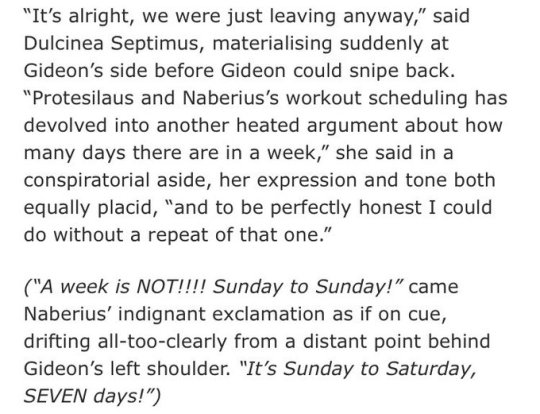
this is of course a reference to the legendary bodybuilding forum thread where they did, actually, argue over how many days there are in a week (cw for ableist slurs in the thread)
---

buzzfeed unsolved meme. i am dirt and i love to eat dirt
---

this is so well-known it’s almost not worth listing it but oh my god they were roommates
---

in itself, this isn’t a reference to anything in particular, but if you didn’t do this on your first read then i’d recommend taking another look at this scene and thinking about the specific wuthering heights/frankenstein/rebecca excerpts discussed by harrow and mercymorn but in relation to canon!harrow’s trauma/relationship with the body in htn :~)
---
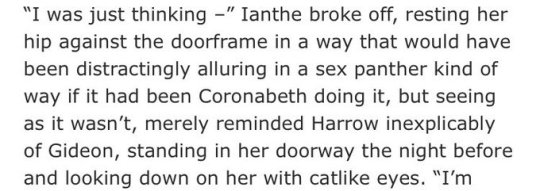
also not really a reference to anything in particular but when i looked back over the fic for this post it struck me that the ‘sex panther’ phrasing was probably at least partially unconsciously inspired by the shoebox project (professor mcgonagall’s oiled man panther was a formative moment for me, truly)
---
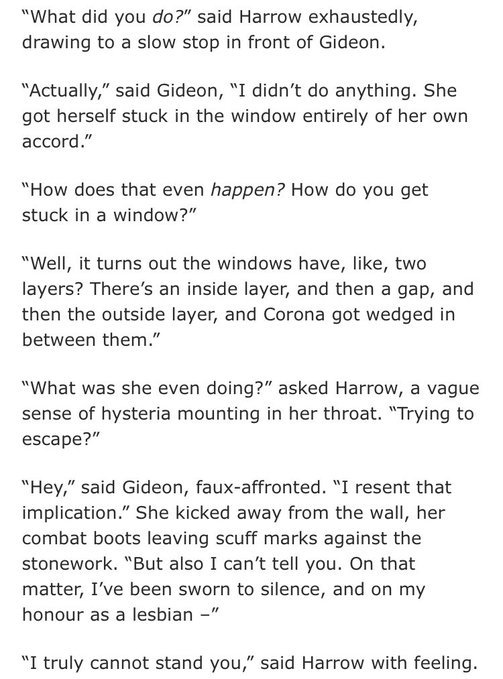
cw gross/unsanitary: it’s the tinder poop window incident. i mentioned this in the end notes of the fic as being what i had in mind for that scene but if it’s too gross for you (UNDERSTANDABLY) then feel free to Death Of The Author me to your heart’s content!
---

i listened to a lot of orville peck while writing this
---
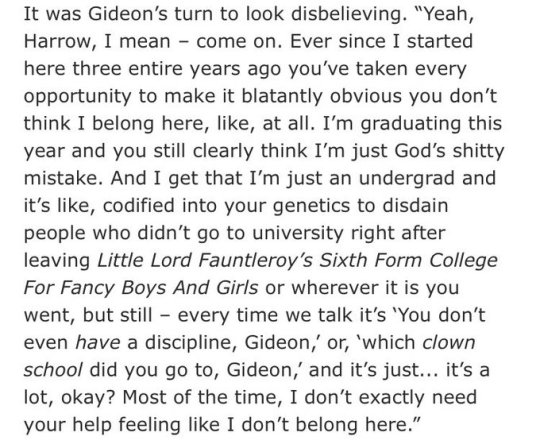
very very very loosely inspired by this clickhole article
---
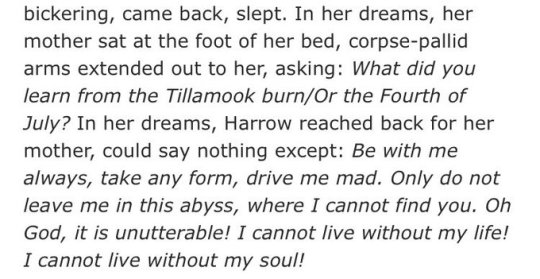
respectively: fourth of july by sufjan stevens / wuthering heights by emily bronte
---

TWO BROS, CHILLIN IN A HOT TUB, FIVE FEET APART BECAUSE THEY’RE NOT GAY
---
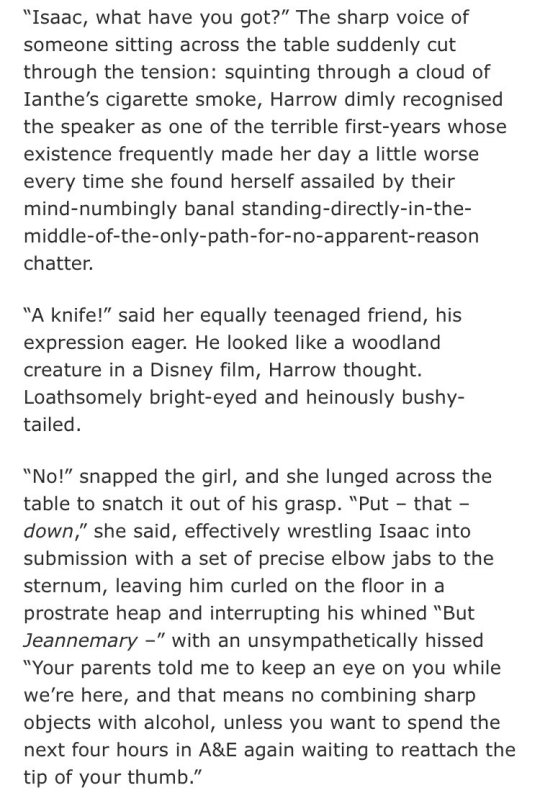
there was absolutely no need to stretch this across three paragraphs, and yet
---

iconic
---

i already linked to this one in the end notes of the fic itself, but it’s good, so here it is again
---

i can’t find the actual original post but it’s this fucking horrible thing
---
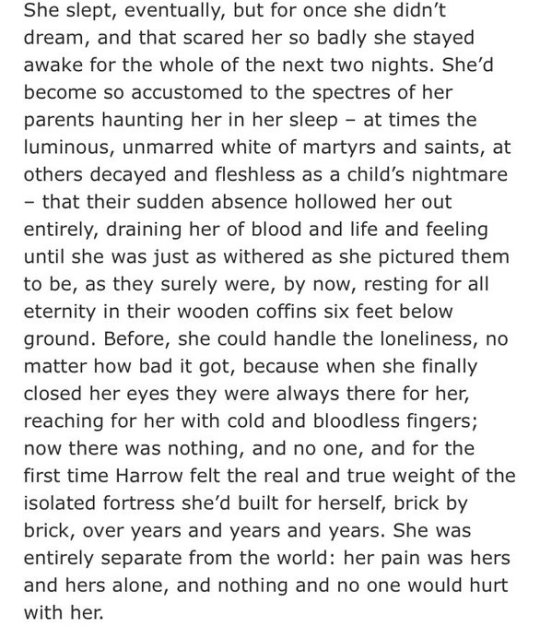
the last line is a reference to the secret history by donna tartt:
“Could it be because it reminds us that we are alive, of our mortality, of our individual souls- which, after all, we are too afraid to surrender but yet make us feel more miserable than any other thing? But isn't it also pain that often makes us most aware of self? It is a terrible thing to learn as a child that one is a being separate from the world, that no one and no thing hurts along with one's burned tongues and skinned knees, that one's aches and pains are all one’s own. Even more terrible, as we grow old, to learn that no person, no matter how beloved, can ever truly understand us. Our own selves make us most unhappy, and that's why we're so anxious to lose them, don't you think?”
---

a lyrical double whammy!
from ‘last words of a shooting star’ by mitski: “they’ll never know how i’d stared at the dark in that room with no thoughts like a blood-sniffing shark”
from ‘a better son/daughter’ by rilo kiley: “sometimes in the morning i am petrified but can’t move/awake but cannot open my eyes”
---

*

shout-out to maybe my single favourite video game moment, the encounter with the sky cat in night in the woods: “There is a hole at the center of everything, and it is always growing. Between the stars I am seeing it. It is coming, and you are not escaping, and the universe is forgetting you, and the universe is being forgotten, and there is nothing to remember it, not even the things beyond. And now there is only the hole... You are atoms, and your atoms are not caring if you are existing. Your atoms are monstrous existence.”
---

“Nothing is ever fulfilled, not until the very end.” - rust cohle, true detective s1, this reference is VERY tonally dissonant because in context it’s actually grim as all hell but w/e w/e i couldn’t resist the shout-out
also harrow quotes from the goldfinch again here! i had the reference included before i read this post and realised tamsyn muir also quotes from the secret history in htn. terrible synergy
---

they are in fact all real. you’re welcome
---
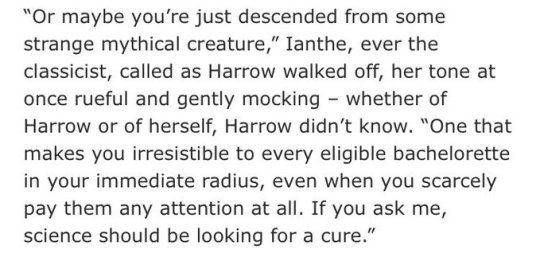
this one’s doing a lot of work lmao. it’s paying homage to this quote by tamsyn muir talking about the draco-in-leather-pants trope in relation to ianthe by loosely referencing drop dead gorgeous, the best drarry fic ever written, in which harry is part veela
---

“It's a very Greek idea, and a very profound one. Beauty is terror. Whatever we call beautiful, we quiver before it. And what could be more terrifying and beautiful, to souls like the Greeks or our own, than to lose control completely? To throw off the chains of being for an instant, to shatter the accident of our mortal selves? Euripides speaks of the Maenads: head thrown I back, throat to the stars, "more like deer than human being." To be absolutely free! One is quite capable, of course, of working out these destructive passions in more vulgar and less efficient ways. But how glorious to release them in a single burst! To sing, to scream, to dance barefoot in the woods in the dead of night, with no more awareness of mortality than an animal! These are powerful mysteries. The bellowing of bulls. Springs of honey bubbling from the ground. If we are strong enough in our souls we can rip away the veil and look that naked, terrible beauty right in the face; let God consume us, devour us, unstring our bones. Then spit us out reborn.” - that’s right it’s another reference to the secret history, with a little bit of mary oliver (tell me, what is it you plan to do with your one wild and precious life?) sprinkled on top for flavour
---

a small one, but it’s the goldfinch again: “And I feel I have something very urgent and serious to say to you, my non-existent reader, and I feel I should say it as urgently as if I were standing in the room with you...”
---

my FUCKING cinnamon apple
what if i... put my minecraft bed.... next to yours... aha ha just kidding.... unless?
---
[cw: suicide discussion in these next two]

*

robyn can have little a rust cohle quote, as a treat.
1. “I'd consider myself a realist, all right? But in philosophical terms I'm what's called a pessimist... I think human consciousness is a tragic misstep in evolution. We became too self-aware. Nature created an aspect of nature separate from itself. We are creatures that should not exist by natural law... We are things that labor under the illusion of having a self, that accretion of sensory experience and feelings, programmed with total assurance that we are each somebody, when in fact everybody's nobody... I think the honorable thing for our species to do is to deny our programming. Stop reproducing, walk hand in hand into extinction; one last midnight, brothers and sisters opting out of a raw deal.”
2. “This... This is what I'm talking about. This is what I mean when I'm talkin' about time, and death, and futility. All right, there are broader ideas at work, mainly what is owed between us as a society for our mutual illusions. Fourteen straight hours of staring at DBs, these are the things you think of. You ever done that? You look in their eyes, even in a picture, doesn't matter if they're dead or alive, you can still read 'em. You know what you see? They welcomed it... Not at first, but... right there in the last instant. It's an unmistakable relief. See, cause they were afraid, and now they saw for the very first time how easy it was to just... let go. Yeah, they saw, in that last nanosecond, they saw... what they were. You, yourself, this whole big drama, it was never more than a jerry-rig of presumption and dumb will, and you could just let go. To finally know that you didn't have to hold on so tight. To realize that all your life - you know, all your love, all your hate, all your memories, all your pain - it was all the same thing. It was all the same dream, a dream that you had inside a locked room, a dream about being a person.”
---

ahaaa this one’s particularly rough. evil monkey no one alive dot jpg
“Later, that dozy embrace solidified in his memory as the single moment of artless, charmed happiness in their separate and difficult lives. Nothing marred it, even the knowledge that Ennis would not then embrace him face to face because he did not want to see or feel that it was Jack he held. And maybe, he thought, they’d never got much farther than that. Let be, let be.” - annie proulx, brokeback mountain
---

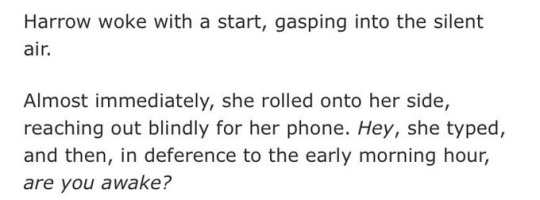
a TRIPLE lyrical whammy!
- harrow’s words to gideon in the dream are a bit of a vague reference to the song ‘adventures in solitude’ by the new pornographers (”we thought we lost you/welcome back”) - gideon’s words to harrow are a reference to the song ‘blush’ by wolf alice (”you’ve got two hands to take all you can/but don’t take too long”) - what harrow texts to gideon is a line from ‘about today’ by the national, aka the most devastating song ever written (”hey, are you awake?/yeah i’m right here”...)
---

i CANNOT find a clip of it but harrow’s repetition of “life is short... it’s short” was me paraphrasing from memory a line from pride (2014), because i am the worst
---
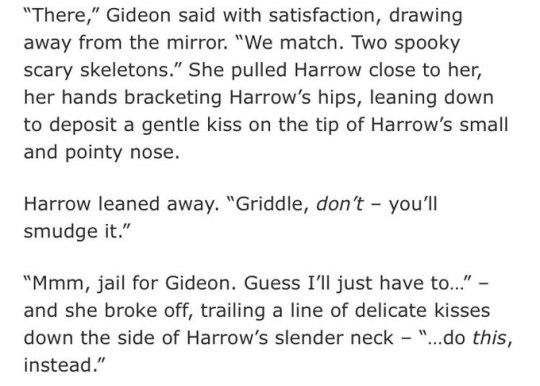
spooky scary skeletons!
“jail for gideon” is obviously a reference to the “jail for mother” tweet that tm also referenced in htn. so, not original in the slightest, but it’s a great tweet
---
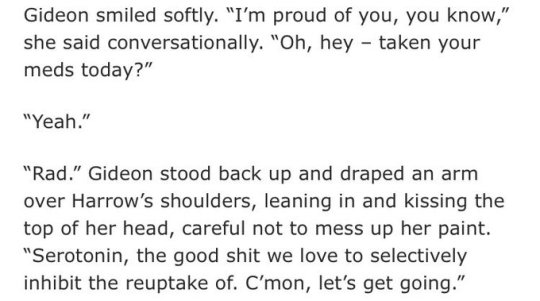
one of my favourite tumblr posts
---

because naberius tern absolutely would watch rick and morty. he would. i know it in my heart.
---
and that’s it, i think. hope you enjoyed this horrid little post and my horrid little fic!
35 notes
·
View notes
Text
Professional sport: Are men and women equal?
In order to become professional in any sport there are many barriers and adversities to overcome. It’s accepted that in life nothing is given to us. However, it is important to recognise that there are many situations, specifically in elite sport where women are not on a level playing field. There are many hindrances that stop or slow down the progression of female athletes.
Women’s sport has come a long way in the last 100 years and those barriers stopping the professionalisation are slowly being chipped away. Although these barriers that stop women from being professional athletes are still very present. I aim to shed light onto these areas and spark conversation as to why and how they exist in this day and age, and what is being done to continue the progress being made for professional sportswomen.
Defining the term ‘professionalisation’:
There are recognisable criteria for what constitutes a professional athlete. All sportspeople at this level will be expected to carry themselves in a well-behaved manner. They should also display good values such as honesty, being charitable, being respectful and hard-working just to name a few examples. A professional athlete must also be committed to the position they hold, also acting in a way which embodies the position of a role model to a younger generation of aspiring athletes. There is also a financial element to professional sport. They would receive funding in terms of the kit they are provided, the transport they take to and from competition and payment on top of expenses is also a condition. They are essentially being paid a living wage to compete within the world of sport.
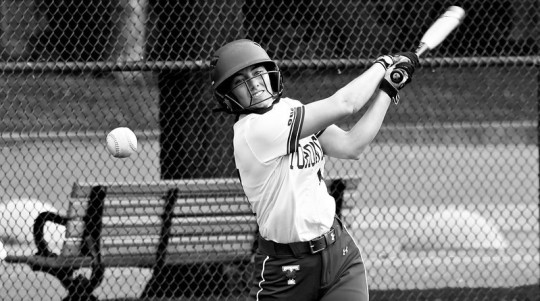
Historical context:
In order to understand the state in which women’s professional sport is in now, we need to understand the historical context. As stated, women in professional sport encounter many problems and have done for many years. Women’s baseball is a perfect example. Talented young women who played softball were scouted to play baseball but only given the opportunity to play professionally due to the vacancy of male athletes going to war in the 1940s. There were many examples of inequality ranging from the expected feminine appearance and etiquette of the female athletes, both when they were and weren’t competing. In addition, the wage they were given was affected, the content of the contracts they signed and all the way to the closure of the league when the male baseball players returned. This raises the issue that sport was seen to be a ‘male preserve’ and not accessible to women.
The timeline of women’s professional baseball:
The video maps out the timeline of women’s baseball in the 40s:
youtube
Sport as a male preserve:
Writing in 1986, Eric Dunning describes sport as a ‘place that serves to insulate men from wider social changes threatening to undermine their traditional, taken for granted, superior social status’. This infers that sport was seen to be a safe haven from any external inputs, and that meant exclusively keeping it a male only activity.
Barriers to professionalisation:
In modern day sport there are still obstructions for women trying to not only become but remain a professional athlete in their chosen discipline. The topic of professional sport for women is more common and more women are professional in recent times, but there are still elements of inequality that exist. Some examples of this are stereotypical expectations, pay inequality and content of contracts.
The ‘feminine aesthetic’:
Firstly, the stereotypical feminine aesthetic where female athletes are expected to look attractive and presentable and are expected to upkeep and maintain this image. An example where the promotion of this was displayed by Sepp Blatter in 2004 when he stated that women footballers should ‘play in more feminine clothes like they do in volleyball’. These comments from the FIFA president were said as a claim that these changes may help grow the women game, but those ideas were not welcomed or accepted. The article below reflects that:
https://www.theguardian.com/uk/2004/jan/16/football.gender
Pay inequality:
Secondly, pay inequality. As mentioned, a common idea of being professional is that an athlete will receive a salary above the expenses they pay in order to make a living. 50% of professional football players who are women do not get a salary, and 30% of them need second jobs in order to make a living. This is a significant problem as it will deter young girls from wanting to become professional footballers. At the elite end of professional football the differences in money is enormous. An example of this is comparing Neymar’s wage at PSG to the combined wage total of every female player in the top 7 women’s leagues. Neymar’s annual wage totalled to £32.9 million compared to £32.8 million divided by 1693 female players in the 2017/18 season. See the link below for a deeper insight:
https://www.dailymail.co.uk/sport/football/article-5117491/Neymar-wages-seven-womens-leagues-combined.html
Contracts:
Thirdly, professional contracts and what they entail. A contract is essentially an agreement between a higher power such as a club and an individual athlete such as a player. Professional women’s football does not only have differences to the men’s game in a financial & player image sense, but also with their contracts which in turn affect their way of life. On average women in elite level football are given a contract which will tie them into a professional deal for a single year, although just less than 50% of women don’t receive a contract at all. The players that do receive their short-term contracts tend to have certain clauses which can bring everything to an abrupt end, such as injury. It is not uncommon that if a professional female footballer sustains a long term / severe injury then their contract can be terminated with immediate effect. This may also apply to lower-level professional male athletes, but this would never be seen at the elite level end of men’s football, sparking the question… where is the equality? See the link below for further information:
https://www.dailymail.co.uk/sport/football/article-6422497/amp/Injured-Womens-Super-League-players-sacked-three-months-notice.html
What do these barriers promote?
Whistle blowing:
Essentially what that means is that a person is willing to stand up and make their voice heard in order to promote positive change. Andrew Goldsmith In 2015 defined this action: ‘The act of whistleblowing centres on reporting an illegal (or unethical) act by an observer who possesses inside information of the wrongdoing’. Looking at how the term ‘Whistle blowing’ in professional female sport is not only present but also key. An individual who follows the defined action of Dunning is essentially risking what little they already have being taken away from them, in terms of salary, contracts and treatment, in order to try to push further into the direction of positive change.
Examples of whistle blowing:
Retired footballer Abby Wambach delivered a speech at a graduation ceremony along-side two high profile male athletes who both had significantly a greater net worth. She took this opportunity and called on the younger generation of athletes to not only be grateful for the opportunities they are given in sport and settle, but to keep fighting for women’s professional sport to where it is considered equal to men. Linked below explains in more detail:
https://www.dailymail.co.uk/news/article-5768613/Former-soccer-star-Abby-Wambach-delivers-best-commencement-speech-year.html
Conclusion:
In conclusion, the path is clear on women’s professional sport. There have been many struggles in history which have carried through into the present day, in terms of the accessibility and opportunity for professionalisation of women’ sport. Although it has been made apparent from both historical and current day examples that there is a movement and belief in pressing for equality. Through the work of activists, women will never be excluded from an element of our society or settle for less than what they are worth. Both in a financial sense but in a respected sense also.
There is still a long way to go to reach true equality in the world of professional sport. But what can we do to influence change? Moving forward we as individuals have a responsibility of spreading the story of it so far, having the courage to openly conversate on this topic with people who are unaware will educate those on the message that needs to be carried forward. The topic of women’s professionalisation should be actively advocated by both genders as the aim of this conversation is to educate all about the inequality on hand. Also, those in influential positions need to utilise their platform to help increase the reach of this message, influencers have great power in our society in relation to shifting beliefs and opinions of their followers, therefore making this an effective action. The cold hard facts of inequality must be taught to the younger population so that they are more equipped to form their own opinions which in turn put them in a better position to influence positive change in the future. We need to ask ourselves as a society on a regular basis ‘what do we believe is right?’, and what we need to do about the situations that rectifying. This will ensure that our ways are never outdated, and the movement of women’s sport is always progressing. Women’s professional sport is not equal to men. Let’s change that.
N0784705
References:
Dunning, E. (1986). Sport as a male preserve: Notes on the social sources of masculine identity and its transformations. Theory, Culture & Society, 3(1), 79-90.
Goldsmith, A. L. (2015). Whistleblowing Intention in Sport: Perceptions, Antecedent Conditions, and Cost-Benefit Analysis (Doctoral dissertation).
5 notes
·
View notes
Text
“Follow Your Own Star”
Lately I’ve found it hard to shake the feeling that everything of value is being destroyed, but we are being given simulacra in exchange, while we wait, to soften the blow. The relationship between the U.S. economy and what actually has value is basically nil, obviously, and COVID has only highlighted that, but beyond that, being in isolation has brought to light how much of what I consider “real” because it exists outside the bounds of money is nonetheless vulnerable. We’ve been given podcasts to fill our working hours with parasocial relationships where once we may’ve had genuine camaraderie with our coworkers. We’re given desultory political candidates to vote for in the absence of those who would govern in accordance with our actual beliefs. It feels like an elaborate art heist is taking place, where the masterpieces are exchanged for forgeries, and the endgame of those seeking to enrich themselves is to set a bonfire of all that’s made us human, all we’ve invested our true selves into. All this can occur only because our relationships have been made increasingly transactional already. I wondered at the start of quarantine how many couples, with the ability to see one another in the flesh compromised, had switched to having “sex” over Skype, how many intimate relationships were compromised by distance into resembling cam shows. Partly this curiosity was a way of comforting myself, as I came to the understanding that I would not be entering into anything approaching a real romantic relationship for the foreseeable future.
In the context of all of this, reading a book that feels reminiscent of the work of another artist feels like a minor thing, but it slips easily enough into the larger pattern. After reading Roaming Foliage by Patrick Kyle, I thought “Huh, this is very much a CF/Brian Chippendale thing.” Then, after reading Eight-Lane Runaways by Henry McCausland, I thought, “Oh, this is even more like a CF thing.” Both are, I think, appropriate for kids, which Powr Mastrs isn’t, but I also never read Powr Mastrs and felt like the thing that made it good was its BDSM pornography elements. People have been biting CF’s style for years — enough for him to address it with a little note in the third Powr Mastrs book, instructing them to “follow your own star.” Simon Hanselmann admits the similarities between the character design for Owl and a character in CF’s story in Kramers Ergot 5, Hanselmann’s subsequent popularity seems to suggest a moment where something becomes less of a direct influence and more just something that exists generally in the world. It’s art: Inspiration, influence, and appropriation are all part of the game. Reading Hanselmann, I’ve wondered what his work would’ve been like before exposure to his most obvious influences; reading these, I wondered instead if they would still have been made had Powr Mastrs 4 ever come out, to finish out the story and close the system; it feels like, in a transactional relationship between artist and audience, the fact of a work remaining unfinished makes it more socially acceptable to steal from. For instance, think of the debt Alejandro Jodorowsky’s The Holy Mountain owes to Rene Daumal’s Mount Analogue. It feels like an attempt to create something with an ending, to satisfy a desire for the logic to reach its conclusion. The comics fulfill a certain set of expectations, I found them a pleasant enough experience, satisfying on a certain level. However, on a deeper level, I found them completely unsatisfying, because they speak so directly to a sense of unfulfilled potential. They lack the thrill that CF’s comics provide, of totally transcending any expectations placed on them.

Measuring the impact made by CF, Paper Rad, and the Fort Thunder contingent is difficult to calculate, because there were so many radical gestures inside that work, and while some have been metabolized, others have not. The “reclamation of genre material in an art-school context” is maybe the most readily understood. Johnny Ryan’s Prison Pit probably wouldn’t exist were it not for these comics, but that’s such a “who cares” for me, such a dumbed-down and simplistic understanding of what makes these comics good. The silkscreening of covers is close behind, in terms of something that people really ran with. That’s fine, no one owns silkscreening, it looks great. What hasn’t really been reckoned with are the gestures against commodity fetishism. Paper Rodeo is progenitor of the free comics newspaper format, but the work that ran there is so much wilder than what you see in what followed, and most of it was anonymous. I understand why that was a gauntlet that wasn’t picked up, but is still one of the things that made an impact on its initial readership. Similarly, I haven’t seen anyone steal the CF format of the single-sheet xerox, with comics on the front and back. I guess that’s not surprising! But honestly? Sick format.
I’ve just been talking about comics, but Lightning Bolt playing on the floor is its own radical gesture, albeit one with an obvious precedent in the form of Crash Worship. The Forcefield oeuvre is its own thing. Those videos are great! The animation made out of photographing the cutting layers of multicolored clay… I wonder how much of this stuff hasn’t been picked up on because it’s the last stand of working with real world physical materials, before the coming of digital as the default medium for art students to work in. Obviously, the silkscreening has similar roots in physical media, and playing on floors relates directly to how you communicate with people when you’re in the same physical space as them. Real world community has distinct advantages, but many that came after took the trade for the benefits working digitally provides. Anyway. I could write a 33 1/3 book proposal for Lightning Bolt’s Ride The Skies that addresses all this stuff, but I also believe I would not be the best person to write such a book; I suspect those better suited would not be interested.
There is something so exciting about artists whose work feels overflowing with ideas, not just on a level of concept or drawing but also in terms of how the work is presented. That whole Providence/Picturebox crew was so abundant with this creative ferment that when I see others picking up on individual threads it makes sense on a certain level — you want more of a certain thing — but if it’s not backed up by something distinctly unique, as a reader I’m hyper-aware of what’s absent.
These artists also made books, and records, and it was their doing so that brought their work to a larger audience, including me. Not everything has to be a gesture against making money. But at the same time, radical gestures suggest the benefits made in fostering community work out better in the long term than leveraging oneself to be consumed as a commodity does. This is not to suggest that McCausland or Kyle are doing something wrong that will sabotage some sort of grand plan for utopia: I’m really just riffing here. If I buy electronic music mp3s online, I’m not necessarily going to lament the death of live music performance the same way I do when buying the mp3s of a jazz act. Looking at a contemporary superhero comic that feels dire and ugly will make me nostalgic for the Mike Parobeck comics of my youth, but a contemporary black and white zine exists in a completely different universe and might not remind me of anything. Certain things make you miss the world that was more than others.
It’s also worth noting that by all accounts Patrick Kyle has a bunch of people online ripping off his style but I have successfully been able to avoid such people. While Roaming Foliage is consciously modeled after the sort of weird adventure comics of not just Powr Mastrs, but also Brian Chippendale’s If N Oof, What I am most often seeing and thinking “that’s a ripoff” is the presence of these geometrical patterns which are also similar to design choices made throughout his oeuvre. There’s a chaotic, obfuscatory energy approach to comics that he works with frequently, but so much of his other comics feel dark, melancholy, or paranoid whereas this feels much lighter in its tone. At the same time, compared to the claustrophobia of Don’t Come In Here, having his characters move about makes for an adventure narrative. Watching them wander, interact, and be given quests and goals belongs to this tradition that’s not unique to the Picturebox artists — but the feeling that this fantasy material was arrived at through adventure games like Zelda moreso than Tolkien makes for this sort of… generational level of familiarity, rather than seeming to occupy some sort of Campbellian myth-space, if that makes sense. The strangeness of Kyle’s art, where backgrounds overtake figures, suggests a sort of PC glitching, almost like the Cory Arcangel/Paper Rad collaboration Super Mario Movie, but achieved through photocopier technology of blowing up and distorting images. It is the sensation of a feeling being chased after that makes the book feel less exciting and more melancholy, though subsequently, that darker feeling might make the book slot into Kyle’s oeuvre so much that bigger fans of his might not even notice the resemblance I’m seeing.
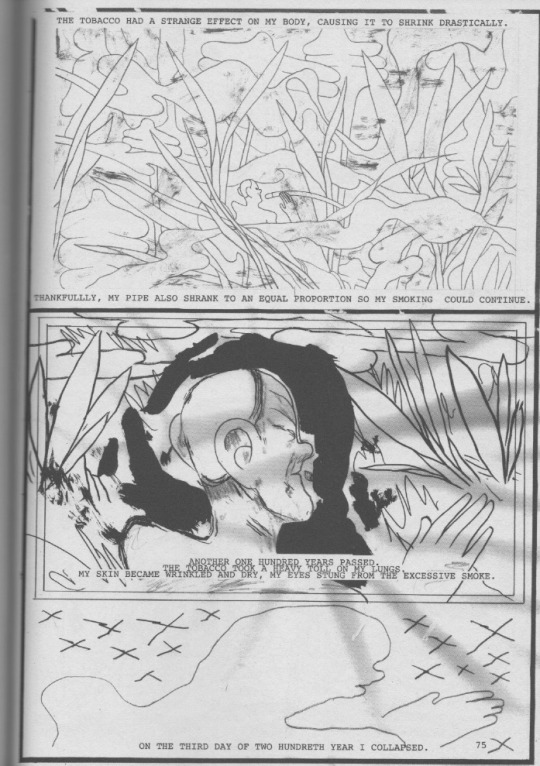
McCausland has a list of acknowledgments in his book which includes CF alongside Herge and Otomo. I can sort of see them all, but Herge especially is an influence that’s been so widely absorbed by comics as a whole that I really only feel particularly aware of it in the case of Joost Swarte or something. McCausland’s resemblance to CF is reinforced by things as molecular as a resemblance in the lettering, which is really odd. The figures all have this youthful smallness to them, and I can’t tell if the characters are meant to be young specifically or if it’s just the way he’s learned to draw. I can see Otomo, but it’s definitely approached through the CF filter. Other trademarks, like the rendering of geometric shapes, the patterns of parallel lines, seems integrated, highlighted, by the “racetrack” premise that gives the book its name. However, he distinguishes himself because his work is more constantly busy, with the same general level of detail. There’s also these trees in the background, which seem like they’re rendered as these painted soft grey daubs, a type of texture you don’t see in CF’s darkened pencil work.
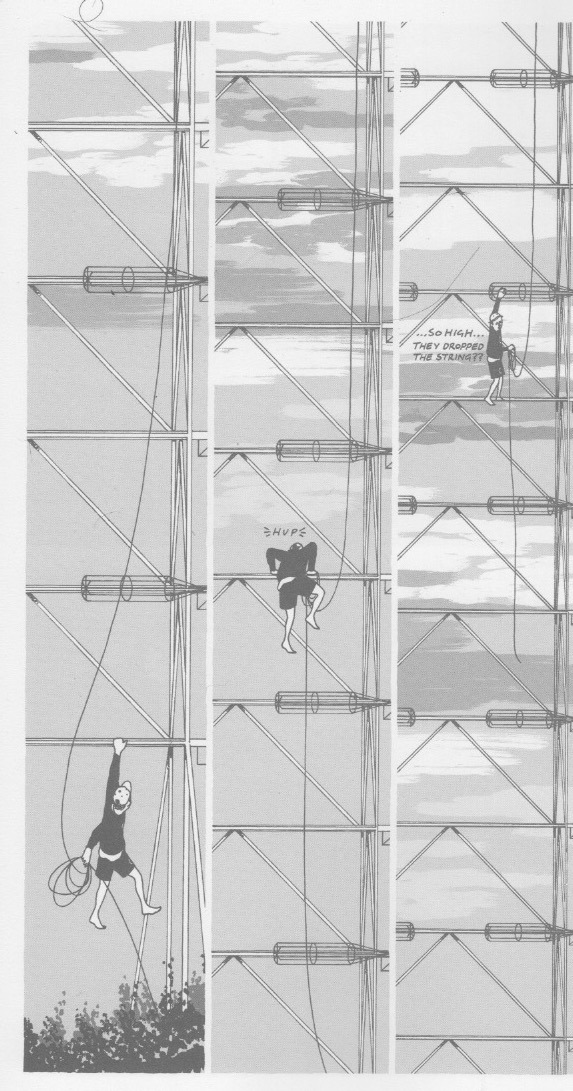
His storytelling is different, prone to large spreads, or showing the same character multiple times in a panel as they move across the landscape. (The dimensions of Eight-Lane Runaways are considerably larger than those of Powr Mastrs.) There are nonetheless panels that seem exactly like CF drawings, but with a less cryptic sense of humor. It feels more populist, like it’s based around what a person liked, and in the act of working it out, subtracted the mystery. What would’ve been a detailed “money shot” in a CF sequence is here the baseline level of drawing detail that never gets subtracted from. It’s really fascinating to me how this makes it less good, I think many people would prefer it.
I wrote most of this before learning that Anthology is releasing a new CF book next week. You can order it and see preview images at the Floating World site. You can draw your own conclusions. CF’s on his own path such that you might not even note a resemblance between his new images and McCausland’s. We’re all living on the same planet, orbiting the same sun in an expanding universe, subject to the will of an accelerating time.
12 notes
·
View notes
Text
Review: Super Mario Sunshine
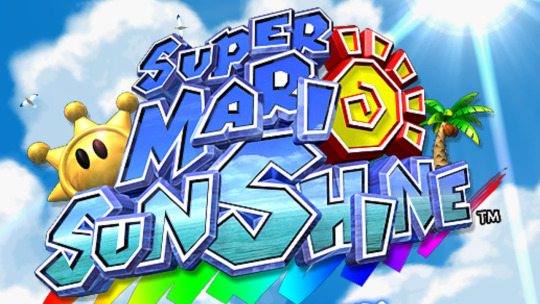
Super Mario Sunshine is a weird game for a lot of different reasons. It was among some of the first game reviews I ever wrote for the internet, for one, all the way back in 2005. I was proud enough of that review that when it came time to relaunch TSSZ News in 2008, it was one of five archived reviews I transplanted on to the site. It was also a strange case where I became convinced it was a game I’d never play, originally. I was 23 years old, with no job, no money, and no prospects. I was desperate to play the game that was being sold as the sequel to Super Mario 64, but I could not envision a future where that would ever be possible.
Eventually, I reached my breaking point. Earlier that same year, somebody had linked me to something called “Quake Done Quick.” It was attached to a relatively new site, called the “Speed Demos Archive”, a hub for videos of people finishing games as fast as possible. The site was small, updated manually, and featured a list of roughly 100 games -- maybe less. This was before Youtube, so these were downloadable video files, usually in AVI or MPG format. And it was here that they had a Super Mario Sunshine speedrun. Even on my fledgling broadband internet, it took a considerable amount of time to download. But, with nothing more than two hours of raw, unedited, uncommentated gameplay footage, I watched a user named “Dragorn” play through the entire game (his old run is still viewable on the Internet Archive). Watching a speedrunner flip, spin, and trick his way across levels, I became convinced that Sunshine was incredible.

A few months later, I was surprised by my brother with $200 for Christmas, stuffed inside a greeting card. He said it was for “all the Christmases he missed” since moving out, years ago. Combined with other money I’d received in gifts, I headed to a Gamestop and purchased a Gamecube with my own (used) copy of Super Mario Sunshine. In my mind, it did not matter that I had spoiled the entire game for myself only three months earlier with the speedrun video. Watching someone else play is no substitute for a controller in your own hands. I needed to play it for myself.
In the modern context, Super Mario Sunshine is one of the games attached to the recently released Super Mario 3D All-Stars collection. Full disclosure: I will not be buying this collection, and I have not played the version of Super Mario Sunshine it includes. It’s not that these games are bad, but even from the outside looking in, the collection looks underwhelming. It’s full of basic, bare-bones ports of games that deserve more. But it does mean that these games have been on my mind, particularly Super Mario Sunshine, which I finished replaying, separately, a little more than one year ago. It was the first time I’d finished the game since that fateful Christmas of 2004, and it provided a refresh in perspective.
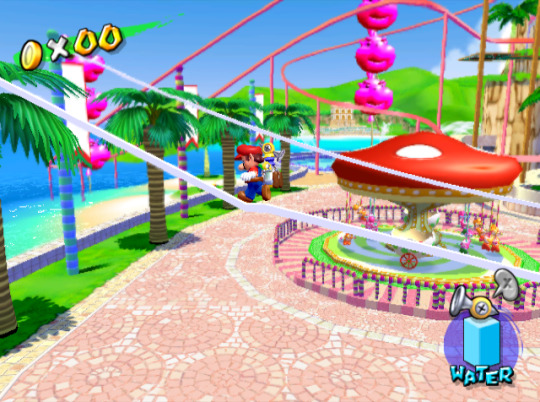
The truth of the matter is, brushing aside everything else about it, Super Mario Sunshine is an easy game to hate. Nintendo was trying a lot of new things with the Gamecube, struggling to figure out what could be done with the leap in horsepower over the Nintendo 64. Their pitch was a Mario that was subtly more serious and realistic. Sunshine is a game with a surprisingly large number of cinematics, and a considerable amount of narrative setup. It sounds like a joke, but it’s true: the game opens with Mario taking a long-deserved vacation on a tropical island, only to be arrested and wrongfully accused of crimes he did not commit. He is sentenced to community service, forced to clean the island of a paint-like substance its residents claim he has used to vandalize their resort town. This is accomplished with the F.L.U.D.D., a backpack-mounted squirt gun perfect for washing down walls and floors. It was the first manual labor he’d been shown doing since the NES version of Wrecking Crew in 1985.
It’s odd territory for Mario, but it leads to the game’s first real problem: Plot. Sunshine is not a game that’s packed with story -- there aren’t a lot of named characters, and there aren’t a lot of genuine story arcs to get hooked in to, but it’s way more than you got in most Mario games. Regardless, the influence of a narrative structure is definitely felt within its levels. One of the benefits of Super Mario 64 is that there was no set order to anything; you might drop in to a level with a specific goal in mind, only to accidentally stumble on to something else. You were encouraged to follow your curiosity, collecting stars more through natural exploration. Even though it’s not always obvious on the surface, the objectives in Super Mario Sunshine are following a specific plotline, which means flat, rigid linearity.

So you might reach an amusement park area, but you can’t go inside until you finish the mission where you open the front gates. Even once you re-enter the level for the next mission inside the amusement park, exploring its various rides will be a moot point, as the game will want you to focus on a specific goal instead. Want to ride the rollercoaster? Too bad, the story dictates it’s not available yet. Though you still have that go-anywhere, do-anything world design from Super Mario 64, the current mission is the only thing that’s ever active. Another example: at the beginning of the game, you open up the first stage -- Bianco Hills. Even though you have a whole village and a sizable lake area to explore, there’s little to do out there, because your mission is about reaching the bottom of the windmill. The second mission, again, doesn’t involve the village or the lake, but now asks you to reach the top of the same windmill in order to fight the game’s first boss, Petey Piranha. And so it goes: big zones to explore, but most of it useless as Sunshine slowly trickles out objectives one at a time, following a barely-visible narrative that drags everything down.
Nintendo had other intentions for the game, too. The company was known for taking its time with game releases -- Super Mario World released in 1990, and it took six years for Super Mario 64 to follow it up. Even once a game was announced, there were often months or even years of delays as the game got pushed back, and back, and back, as with Ocarina of Time. Similarly long waits happened for many of Nintendo’s other flagship franchises (Super Mario Kart, Super Metroid, etc.), and the peanut gallery was getting restless. With the release of the Gamecube, Nintendo made a vow to explore other avenues to release more games, more quickly.

The problem was, all of those delays are exactly what lead to Nintendo’s extremely high bar of quality. Rushing these games out the door meant cutting corners and finding easy ways to tack on extra play time, skipping necessary fine tuning. In The Wind Waker, this notoriously led to the last fourth of the game, wherein you must find and decode maps to dredge up half a dozen pieces of the magical Triforce. For most, this meant hours of sailing out to random, completely featureless areas in the middle of the open ocean hoping to find a single golden tortilla chip. “Tedious” is putting it kindly, but it saved Nintendo from having to delay the game too many times in order to add more in-depth content.
In Super Mario Sunshine, this manifested in a degree of repetition that is difficult to ignore. In both Super Mario 64 and Super Mario Galaxy, most mission objectives are unique. There are occasional repeated missions, like finding 8 red coins, but by and large it's things like rescuing a baby penguin, opening a pyramid, assaulting an airship, or finding your way through a gravity-bending maze. There's enough variety that you don't notice as much when you're asked to do yet another one of Galaxy's purple coin comets.

Sunshine still has unique goals like that, but they are much fewer and farther between. Instead, the bulk of the game is filled with doing the same four or five missions over, and over, and over again. Finding fruit to hatch Yoshi or hunting red coins can be fun occasionally, but Sunshine often makes you do this stuff multiple times per level. Most bosses also must be faced at least twice, sometimes up to three times, and very little changes from fight to fight. And then there are the races -- a man named Piantissimo is waiting for you in most stages, looking to race you to an arbitrary landmark, and every single level has one penultimate mission where you must chase down the hero's evil doppelganger, Shadow Mario. It’s padding, basically, and thanks to a tenuous grip on narrative, there’s few ways to skip the things you don’t want to do.
This isn't even touching on the game's blue coins. They're one of Sunshine's rarer collectibles, and ten blue coins can be traded at the shop for a single Shine Sprite (the main item central to the story). The majority of blue coins can be found by hosing down graffiti found around the island. Spray a circle-shaped pattern on one wall, and a blue coin pops out of another circle-shaped pattern on the opposite side of the level, which you must run to and collect before it disappears. Then, the opposite: spray down the second pattern, and another blue coin will appear back where the first graffiti used to be. In a game full of rerun objectives, this is the worst offender. Rarely are these blue coin graffiti spots interesting or challenging; they primarily exist to fill space and fluff up the Shine counter.

The level concepts themselves also suffer from this repetition. In any other Mario game, “tropical island” would be one theme among many other level types, like deserts, volcanoes and frozen lakes. Sunshine tries to stretch its one theme out to last an entire game, and in practical terms, this means that even after 18 years and two complete playthroughs (three, if you count the speedrun video), I still can’t remember most areas in any kind of specific detail. I remember a couple stage names, maybe a few environmental traits (like the hotel at sunset or the amusement park), but anything beyond that and it all starts blurring into homogeneous beaches, docks, and villages. Even the music -- beyond the iconic acoustic guitar of the Delfino Plaza hub world song, absolutely nothing about Super Mario Sunshine’s soundtrack stands out as memorable in the slightest. Every part of this game plays, looks and sounds like every other part in the worst way possible.
And yet, through some miracle, Super Mario Sunshine does not come out the other end being a bad game. It’s not necessarily good, either, mind you. But when I finally managed to get my hands on this game back in 2004, it made me angry. Super Mario 64 was a tough act to follow, and rather than build on those concepts, Sunshine felt like a massive regression. Nowadays, it’s easier to see the bigger picture. Super Mario Sunshine was a stop-gap as Nintendo slowly pushed Mario back to a more linear, level-based structure. Super Mario Galaxy was another step in this direction, doing away with the open worlds in favor of traditional, straight-forward level design, something that would later be perfected in Super Mario 3D Land and Super Mario 3D World.

That makes Sunshine more of a curious black sheep than anything else. It’s definitely not a game worth hating -- its biggest offense is simply being dull, and there are worse fates. For my replay, it became the sort of game I chipped away at, bit by bit, over the course of nearly three years. As it turns out, the best cure for repetition is to forget everything you were doing the last time you played. It’s even fitting on some level that a game about Mario taking a vacation is best served in lazy, slow, indifferent chunks. Make no mistake -- there are better, more polished, and more engaging platformers out there for you to play. It is in no way a stretch to call Super Mario Sunshine the worst 3D Mario game, but it speaks to the franchise’s high bar of quality that even the worst 3D Mario game really isn’t so bad.

9 notes
·
View notes
Note
Can I ask how you’re a trans man who’s also ok with female pronouns and calling themselves a woman? Just a genuine question. I’m a young adult who’s gnc and consider myself trans, but I also agree with some points in gender critical discussions
It’s complicated. This blog has been one big exercise in desensitization for me, coming to terms with female-specific language and such when applied to me. They’ve always been big sore points for me and getting misgendered has been difficult to cope with, but I accepted from the very beginning of making this blog that I’m participating in feminism as a female - an insider, not an outsider - and as such, I have to grow a thicker skin when it comes to being called a woman and being referred to with feminine terms. It’s worked out pretty well, I’m much less upset by them now than I was three, four years ago.
Part of it is also necessity. I stopped hormones for health reasons three years ago, and with that I had to accept that I’d be perceived more and more as a female than before, so I have to learn to cope with it. I have to stop freaking out every single time it happens, because it’s not malicious, it’s just perception. It isn’t inherently malicious, dangerous or harmful to me. It’s okay to be seen and referred to as a female. I’m not physically hurt by this. I’m still scared of it in unsafe situations of course, but they’re rare, and in a general context I have to be alright with the fact that I’m ambiguous and some people will read me as female and others will read me as male and this will likely be how I live for the rest of my life.
Third thing is that my native language is Finnish, so I don’t actually run into pronouns in the wild at all. Finnish isn’t a gendered language, we only have a single neutral pronoun for humans and we don’t even use that for each other, everyone just refers to everybody as an “it” instead. So the pronoun thing pretty much only exists during travel, which covid has now killed in the long-term, and online, where nothing is real and the pronouns people use for me depend entirely on the context I’m being addressed in. In a video game I’m automatically a “he” because women don’t exist on the internet and also if I participate in voice chat then that’s it, and in a feminist space I’ll automatically be a “she” because... you know, I’m a blogger blogging about feminism from a female perspective.
I struggle with “woman” the most, because it carries such a heavy baggage well beyond just its neutral meaning of an adult human female. Nobody can say that it doesn’t. I still hate that word and I’m not sure I ever won’t. In Finnish, I can’t stand being called a woman still. That hasn’t changed. But there really isn’t any practical reason for me to be offended about the word, so I’m practicing. It’s just a word. My life literally does not end when I’m referred to as a woman, even if it makes me feel ill. I can crawl closer to a neutral standing with the word through practice, through more positive associations. It doesn’t have to feel like a bad word or a threat like it does now, because it isn’t.
Silver linings are that I’ve always been very connected to my female reality, and as a well-trained man hater from childhood I have a certain pride attached to that despite having dysphoria and obviously struggling with the social side of things. I also heavily identify as wlw, and even if I was someone’s boyfriend, I’d be that as a trans man, not a male man, and that makes all the difference to me and hopefully any partner I’d have, too. I’m proud of being same sex attracted and I am fiercely dedicated to the community, and my dysphoria will not rob me of that, and it can’t make me reject my lived history, reality and the love I’ve felt for other females as a female in my life. Therefore, again, I have to have some kind of nuance here. I have to accept that male pronouns and such can be tricky in this environment, and confusing to use in this context.
So tl;dr: context matters, but also I just don’t want to be sensitive to neutral words, and I want to get over my gut reactions to them. It’s not a priority, but I’m practicing.
3 notes
·
View notes
Text
A HANDY DANDY GUIDE TO WRASSLIN
For the lovely, the wonderful, the incomparable @gideongrace , may I present: Daggs’ Guide to the Wild Ass World of Professional Wrestling! (and it’s goin’ behind a cut because It Got LONG!)
So, here is the things. Wrestling is STUPID. And great? And fun as hell! And the most carny sport to ever exist. But, also SUPER inside baseball a lot of the time just because it’s got such a long goddamn history that it can seem daunting to get into. Like I’ve only been back into it the last four or so years, so there’s a lot of history that I’ve missed! There’s also a whole lot of gate keeping, just like comics or video games. There’s also the bitter truth that a lot of people in the industry are absolute shitheels that should have been fired long ago (and I’ll only be vague about a lot of that). So, yeah. A WHOLE LOT.
First things first: HISTORY. There’s just so much. But, conveniently? You don’t need it. It can be fun if you end up really like wrestling, but contrary to what a bunch of middle-aged, racist, misogynist and WILDLY homophobic, White American Men will tell you, you don’t actually need it to enjoy yourself. If you DO want history, might I suggest the How2Wrestling podcast! It is a cheerful, lovely show hosted by two goddamn delightful humans, Kefin and Jo (who are also just wonderful people to interact with in general)! There is also the Comic Book Story of Professional Wrestling by Aubrey Sitterson and Chris Moreno, which is a great read! Wrestlesplania is another good show for history of the sport and the wrestlers! They’re definitely, uh, hornier, but v fun!
Secondly: On the subject of inside baseball, wrestling jargon is a whole thing. The ONLY part of wrestling history that is 100% important: it is a carny sport. Like, some side-show, vaudeville ass shit, yo. And it has never evolved from that, so there are a whole lot of terms used that are very specific to like... early 1900′s carnival culture. Here is a wikipedia article, but there’s also a wonderful How2Wrestling episode about it all! I’ll try not to use much!
Thirdly: We can’t talk about wrestling podcasts without mentioning Colt Cabana’s The Art of Wrestling. A lot of the archives are behind a paywall now, but the show is great. If you DO get into wrestling and start to find wrestlers you enjoy, I highly highly suggest checking to see if they’ve done an episode. Colt is a goddamn delight of a human, deserving of support and a great interviewer on top of it. Even if you just bookmark eps you’d wanna listen to and then start a free trial to marathon them all. (See also: the Colt Cabana & CM Punk lawsuit(s), in which Colt got royally fucked over.)
Fourthly: Nobodies Watching Wrestling. Drag Queens watching wrestling. That’s all you need to know. Even out of context, they’re goddamn delightful humans. Might I recommend this episode with EFFY, because I sometimes just watch it when I’m having a bad day.
Fifthly: Tights & Fights is a great weekly wrestling pod, and is how I keep up on a lot of things that I might not be watching. PLUS, diverse group of (wonderful) hosts: Hal Lublin, Daniel Radford, Lindsey Kelk, Open Mike Eagle, and producer Julien Burrell. They’re just great. And horny, at times, but in a charming and respectful way.
Now... The boring part. I’m just gonna get some of the popular company introductions out of the way, and then the fun part of So Many Match Suggestions at the bottom. But, business first! (The Big difference between Larger Companies and Independent Companies is that the big guys have a contracted roster of people who sometimes can work with other companies [unless they’re the WWE, who have exclusive contracts and still call their employees Independent Contractors so they don’t have to offer health insurance or a union], and indie guys contract people usually show-by-show. ALSO, there is intergender wrestling [men vs women, which does bother a lot of people. I do side with support of it, but I do totally get how it can be hard to watch] in indie shows, whereas there is NOT in 90% of the big companies.)
(And, honestly, if you wanna skip this part, you can, but if I don’t do it first, I’ll forget..)
AN OVERVIEW OF THE BIG PLAYERS
WWE - Here’s the thing. The WWE kinda... is a terrible capitalist bastard of a company, run by a morally bankrupt, egomaniacal, shitstain, roid-rage cryptkeeper of a man. And, if you want my personal opinion, RAW and Smackdown are both (currently) TERRIBLE shows, despite having some truly phenomenal talent. BUT, but. NXT (and NXT UK) is probably the best, like, weekly wrestling show (on TV, at least, but we’ll get there). The talent is INCREDIBLE, the storylines are less bad bananas, and they’ve adopted a LOT of the best indie talent lately (because they want to directly compete with AEW, but that’s a whole other thing). WWE programming is also the easiest to get a hold of because they are the longest running and basically Disney, so there are some full matches on YouTube, and Raw and NXT are available on Hulu. They are also releasing a lot of free stuff on the WWE Network that you can watch without signing up for a paid account, but there is a lot of stuff behind a pay wall.
Cons: Real Talk, run by a bunch of terrible people. Responsible for covering up a lot of truly reprehensible crimes for which no one was held accountable, despite being well documented. A blatant disregard for the (physical and mental) safety and/or financial security of a lot of their roster--specifically the people you don’t see on TV. (If you want some history, you can look through the past tweets of the New York 64 Tournament, but a lot of it turned my stomach, so I would not suggest, but it’s there if you have the same morbid curiosity that I did)
Pros: The company might be run by terrible people, but their roster is good. A lot of my top wrestlers do work for the WWE, sure, but they do hire a lot of decent humans that I sometimes feel bad about not supporting. Also, it is the dream of a lot of people to join WWE simply because of the prestige, the massive audience, and job security. I might hate Vince but I can’t begrudge any wrestler currently working for them.
NXT Pros: On the subject of rosters, NXT is LIT. But they have also stolen some of the best indie wrestlers recently: Mercedes Martinez and Jake Atlas, two of my All Time Favs. Both of whom deserve the world, because being openly gay in the wrestling industry is the pits.
All Elite Wrestling - AEW is a very new company, and they are my favourite of the big promotions. They are a company run by wrestlers, rather than a millionaire with a writing staff. I like the wrestling style(s) better, I was a huge fan of a lot of their roster before they hit TV last October, and I like not giving the McMahons money. The storylines are better, if only because they don’t have a writer’s room dictating scripts and such, and the characters are more fun (for me at least).
Easiest ways to watch for free: Their YouTube channel! There you can find a lot of highlights, behind the scenes, AEW Dark (the “dark” matches, or the non-televised matches from TV tapings), PPV pre-shows and a lot of stupid stuff.
Cons: A bit of an issue offering equal match time to the women’s roster the way they SAID they would at the start. A bit more violent of a style as a lot of the wrestlers came up death match style wrestling, or are from Japan/wrestled in Japan and typically wrestle “strong style” (wrestling style with less theatrics and known for Real Real Strikes that Hurt A Lot), which some people can find off-putting. Also, they hired Jake Hager, who is a real piece of shit.
Pros: Have a wonderfully diverse roster. Orange Cassidy. Sonny Kiss. Good storytelling. Jake The Snake Roberts doing Hella Promos. The Dark Order, who we affectionately refer to as the Spooky Perverts. Chris Jericho yelling at a Drone, and Matt Hardy being a wizard. A bunch of wrestlers who are married to other wrestlers who work for WWE, and good jokes are made.
BUT THE BIGGEST PRO-AEW THING I CAN PROVIDE: NYLA FUCKING ROSE. They didn’t make her the first women’s champion like they should have, but they put her in the first championship match on the FIRST episode of the weekly show, Dynamite, and she is now the CURRENT women’s champion. I don’t wanna make a big deal, only it is a BIG DEAL, because Nyla Fucking Rose is the first openly transgender wrestler signed to a major promotion, and if you think I didn’t fucking CRY LIKE A CHILD when she won, you’re wrong. So, yeah, a NATIONALLY TELEVISED WRESTLING PROGRAM’S CURRENT WOMEN’S CHAMPION IS A TRANSGENDER, FIRST NATIONS WOMAN. NYLA. FUCKING. ROSE.
As of right now, AEW seems to be done filming, which is both Very Smart and also heartbreaking, but you can find all the ways to watch over here on their site if it looks like fun!
WOW Women of Wrestling - Have you seen GLOW? This is a show created by the IRL creator of GLOW (the promotion the show is based on, not the show)! And it is? Incredible? The characters are fun and portrayed as superheroes, the stories are CAMP af, and the wrestling is GOOD. They’re a non-traditional show, which is fun. Their roster is made up of wrestlers playing different wrestlers. Wrestling is a bunch of super talented people playing characters while doing acrobatics. WOW gives us people playing characters, playing other characters, while also doing acrobatics.
Cons: All male announce team? On an all women’s show? Excuse? And also: Tessa Blanchard who is, it turns out, a great big racist. Also a little harder to get full episodes it seems.
Pros: Literally everything else.
Ring of Honor - For awhile ROH was handily competing with WWE. And then they weren’t. And then they got better. And then they got worse. And now, currently, they are a company that I hate supporting.
Cons: Run by assholes who don’t care about worker safety, and don’t put anything into the women’s division.
Pros: Sometimes they partner with New Japan Pro Wrestling. They’ve recently released a lot of goooood old matches including some Kevin Steen (currently WWE’s Kevin Owens) vs El Generico (definitely, 100% not at all, no way, no how, of course NOT WWE’s Sami Zayn [he is, this is another inside baseball joke that I’m just obligated to make every time I mention El Generico]) matches which are BRUTAL. Oh, and Dalton Castle:
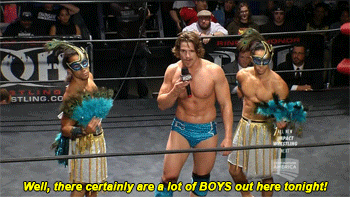
Impact! - It’s back! I don’t watch it, but they DO have Rich Swann, so they can’t be bad. There is an entire history to Impact that is BANANAS. Like AEW, a bit more rough and tumble, scrappy death match folks, and I like a lot of the roster, like Taya Valkyrie, Jessika Havok and Sami Callihan. Not a bad show, but the full show weekly doesn’t hold my attention.
Cons: Tessa Blanchard, mostly. She is an incredible wrestler, her matches are good, but.
Pros: Pretty easy to watch, actually? I believe they’re still on Twitch, and they have an entire channel on Pluto TV.
New Japan Pro Wrestling - NJPW is GREAT. Definitely not everyone’s cup of tea. The shows are long, and strong style just... hurts. Like, a lot of wincing on my end. But the wrestling. Oh, lordy, the wrestling is incredible. But it is brutal. Strong Style wrestling is much different than the typical American style that you see in WWE, and a lot more grounded than high flying lucha styles. (Though a lot of wrestlers do travel to Mexico and train in lucha style wrestling (which I am the least familiar with), so currently there is a lot of the very high flying flippty dos and the absolutely brutal strikes that you see in strong style wrestling.)
Cons: Show/match length is typically long and there is A Lot to See. The only way I know to watch full shows is through their streaming service.
Pros: Just the whole thing, really. They release a free match on YouTube every Monday. Also, Toru Yano, the best wrestler in the world.

Indie Promotions that I know less about because I can afford only so many streaming services
Firstly, here is a Wiki list of wrestling streaming services. I’m gonna name a couple below, but the wiki page has a handy list of costs of the bigger ones because capitalism knows how to get you. (Personally, I only use IWTV at the moment. They’re a good company run by good people, and a lot of indie promotions would have died out without partnering with/support from them)
Beyond Wrestling - Beyond is My Favourite Promotion To Watch, Bar None. Their weekly show (when in season), Uncharted Territory, is fantastic. Diverse talent, diverse styles. They do have a lot of death matches, which can suck to watch if you aren’t into that sort of thing. I am, it turns out, into that sort of thing. But listening to interviews with a lot of death match wrestlers, specifically Jimmy Havoc, can help understand the w h y of it all! Available on IWTV.
Chikara - Chikara is So Fun! They are a (mostly) family friendly promotion and training school. Their shows are filled with young/newbie wrestlers as they learn the tricks. Run by Mike Quackenbush, who is a delightful person, BRILLIANT wrestler/trainer, and someone who is willing to take the safety of his people into account. He’s good people, who trains good people, and supports good people, and gives them a safe, open place to learn. It’s also very fun! A lot of comedy matches. Watch on: CHIKARAtopia or some of their archive is on IWTV.
EVE - An all-women promotion, providing a safe working and training environment for women and girls. They have put their foot in it on occasion, but they seem to still be good people. (I would recommend the Tights & Fights episode with founders Emily and Dann Read for a little backstory on the company, but not needed.) Ways to watch.
RIPTIDE - YO, RIPTIDE IS DOING THE MOST BEAUTIFUL SHIT. Cinematic wrestling, and it is great. The matches are good, the promos are good, the people are good. But the way they film it oh my god holy shit. When everything is a little less hectic, they are people I am definitely gonna support as much as I can. Watch here.
A Matter of Pride - Here’s the thing. They have put on some very good, inclusive shows. However, some serious allegations have come out about Rick Cataldo, who is involved with the company, and I think it’s important to mention. They have done a lot of good in the world of prowrestling and they put on good shows and they have given a platform to people who might otherwise have been pushed aside, however bad things have still happened there. Watchable on YouTube.
OTHER NOTABLE INDIE COMPANIES
GCW (IWTV, Fite TV & Smartmark) * Black Label Pro (IWTV) * Prime Time Pro Wrestling (IWTV) * Uncanny Attractions * RISE (IWTV) * Bar Wrestling * PWG * Stardom * Bizarro Lucha (IWTV) * OTT
There is also NWA Power that is a good show on YouTube, however, they immediately hired (and now fired for being racist) Jim Cornette who is... just an absolute jackass. But I do feel I should mention them.
Is that over? Yes? Well..
NOW THE FUN PART. THIS IS MY MOMENT. THIS IS THE ONLY PART THAT REALLY MATTERS.
So. The thing is. Wrestling is A Lot. SO, I’m gonna give you as wide a variety as I can! I’ll point out some fun people, some fun gimmicks and HOPEFULLY won’t completely turn you off! If you enjoy any of these, then the dumb stuff up above is useful!
First! The most important wrestling match of All Time. Invisible Man vs Invisible Stan. This is everything you need to know about the beats of good wrestling, but also why wrestling is fun. There are two people in this match: Referee Bryce Remsburg and the audience. And that’s it. This is literally just a referee (but it’s Bryce, so the referee) miming a wrestling match, and an audience buying into the kayfabe wholeheartedly. (Inside baseball: Bad Boy Vision - “Bad Boy” Joey Janela’s [another wrestler] sunglasses)
One of my favourite matches in recent memory, AND one of the best matches sort of just in general! David Starr vs Jordan Devlin at OTT. Quintessential wrestling, fantastic storytelling, and one of the best promo packages I’ve ever seen. BONUS: David Starr is a GREAT human fighting day and night to unionize the wrestling industry. He’s the Bernie Sanders of professional wrestling.
I thought about putting an actual death match on the list, but the closest I will get is this Nick Gage vs Josh Briggs fans bring the weapons match. I chose this match because my very best friend does not like this style of wrestling at all, but he did enjoy this match. It’s a lot, obviously. But it’s not as bad as it could be, but there’s also no shame if it isn’t your thing. Hell, I don’t even know why it’s my thing! I don’t even like bloody horror movies! I will say that Nick Fuckin’ Gage is one of the most prolific death match guys still working today, and also one of the nicest, kindest, most beloved guys there is and I would die to protect him. MDK!
Okay, this is the single most beautiful match to exist. Cara Noir vs PAC (fka WWE’s Neville). This isn’t wrestling, this is art. Great story, no commentary, gorgeous camerawork. Bonus: Cara Noir has the most fantastic and well rounded gimmick (character) in the business. Have you seen Black Swan? That’s it. That’s his character. And it’s great. Nailed. It.
Oh, did you know David Arquette is a wrestler? HE IS! Here’s he and RJ City.
On the subject of WWE and NXT, this Halftime Heat match of Aleister Black, Ricochet & Velveteen Dream vs Johnny Gargano, Adam Cole & Tommaso Ciampa. These are six of the best wrestlers work, and definitely TOPS in the WWE system. SEE ALSO: Black & Dream put on a HELL of a program together at NXT, but it’s been boiled down to this highlight vid that gives me feelings. Gargano vs Andrade Cien Almas is one of THE BEST matches of all time and here is a shitty highlight reel, but it’s still good. Adam Cole is 1) incredible and 2) the prettiest possum in the Denny’s dumpster, have a Cole vs Finn Balor highlight reel. God, I wish it were easier to find WWE stuff on YouTube.. All these matches should be on Hulu, tho.
NEXT! Kris Statlander vs Davienne for Beyond. Kris Statlander is A Legend, despite being real new to the business. Currently wrestling for AEW, former stuntwoman and, most importantly, she’s an alien.
FREE FOR ALL TIME. Solo Darling vs Penelope Ford vs Veda Scott vs Ashley Vox. They didn’t have to go that hard, but they did.
SPEAKING OF. Kylie Rae, Penelope Ford, Kimber Lee & Skylar vs. Shotzi Blackheart, Harlow &Twisted Sisterz. I just? I love? All of them?
And not to mention Kris Statlander vs Priscilla Kelly. I mean, I mean. I cannot sing the praises of both of these women enough.
Okay, so I am really only passingly familiar with a lot of Japanese wrestling. Mostly got into it last summer, actually. I get it, I love it, but I’m not as well versed in the people involved. Two badasses I do know? Meiko Satomura vs Kana (WWE’s Asuka). Fucking legends, both of them. Hard hitters, too, jesus.
If you do get into NXT at all, Keith Lee and Donovan Dijak put on one fuck of a program together, but the story started long before they ever entered the WWE! Please enjoy this absolute hoss fight from a couple years back.
NOW, some intergender matches! If you think they aren’t your thing, feel free to skip!
A fun match of (current IRL romantic partners) Keith Lee vs Mia Yim from before either of them debuted at NXT. I believe they weren’t dating at this point, so the next part will really hit, cuz it’s romantic as shit... This was not the booked ending. Keith Lee didn’t kick out on purpose. (Which, I mean, is literally all wrestling endings, but.) Mia was booked to lose (at least they told her that), and he purposefully took the L and went out on his back, to surprise her and give her a MASSIVE push.
Leyla Hirsch vs David Starr. I just. I goddamn love Leyla Hirsch. A very young wrestler, very new to the industry and I just love her so much?
Two great, intense matches of Joey Janela, the patron saint of bad decisions. Versus Kris Statlander (I can’t get enough of her) and versus Jordynne Grace.
Orange Cassidy and Penelope Ford vs Shockwave and Veda Scott. Shockwave is a robot and Orange Cassidy is Paul Rudd in Wet Hot American Summer. I can give no other explanation.
COMEDY TIME, YO. Comedy wrestling is The Best. There’s a name, Orange Cassidy. Yeah, he’s very funny, and also the most divisive person in wrestling rn. He’s Paul Rudd. He knows he’s a wrestler. He’s lazy. And there’s one match that we need to get out of the way first...
Orange Cassidy vs David Starr. The thing is. Orange Cassidy can fucking wrestle. His gimmick might be that he doesn’t want to, but he can. And It. Is. Great.
Now we can get on with the funnies.
Orange Cassidy vs Colt Cabana. Not story needed. Just two dudes at a food festival. Oh, yeah, there’s also a Swamp Monster. We love Swampy.
Colt Cabana vs Toru Yano. It’s just. So. FUN.
You might know the name Joey Ryan as The Dick Flip Wrestler, or The King of Dong Style. His dick has magical powers, it’s a thing. Here’s he and Orange Cassidy.
Johnny Cockstrong is the opposite of Joey Ryan. Literally. Here’s him also vs Orange Cassidy.
Did you want to see a Dick Test of Strength between them? Well, it happened.
Back to RIPTIDE for (another intergender, kinda) Pete Dunne, Tyler Bate & Trent Seven vs Joey Ryan, Candice LeRae (the World’s Cutest Tag Team) & Colt Cabana.
Kinda almost but not really comedy but very funny and also full of good wrasslin’, here is EFFY vs Orange Cassidy. Pirated, technically, and in real low quality, but I Love It. EFFY is Daddy.
Now, you’ll notice not a lot of women in the comedy section. Real talk, women still tend to get treated as a joke by the wrestling industry at large, so they don’t get the luxury of being as funny as they want. But one woman out there doing the lord’s work is Session Moth Martina. Legend. Love her. Admittedly, another intergender match, but it makes me happy. Martina & Orange Cassidy vs Joey Janela & Penelope Ford (Janelope).
One of my All Time Favourite Matches to date, EFFY and Danhausen (Gaytanic Panic) vs Chris Dickinson and Pinkie Sanchez (Team Pazuzu). Yes, this is a Halloween show. Yes, the Ref IS dressed as Chris Dickinson. There are teeth, Jesus resurrects someone, Danhausen is in fishnets and Effy is in face paint. It’s great. Love that Danhausen.
And there we have it! A whole lot of information and a bunch of matches and some stuff. It’s real dumb, and sometimes the industry is dark, but there’s a lot of hella good people doing dumb things. I hope this was helpful?? And Fun! (But my feeling won’t be hurt if it wasn’t fun, I promise!)
I leave you with this, RJ City making coffee in his underwear with Danhausen. Completely out of context. Because I love it.
9 notes
·
View notes
Video
youtube
We’re talking about adventure games again! Or, more accurately, we’re speaking in the context of adventure games about why some genres are hard to define, different ways of thinking about genre, and what genre is even for.
If you'd like to see more work like this, please back me on Patreon! Transcript below the cut.
Hi! Welcome back to Who Shot Guybrush Threepwood? Meditations on the life, death, and rebirth of the adventure game.
Adventure game.
Adventure game.
Ad. Ven. Ture. Game.
What kind of name is that, “adventure game”? It’s an atypical way of categorizing video games, I’ll say that much. We usually give game genres titles like "first-person shooter," "real time strategy," “turn-based role-playing game.” Real nuts-and-bolts kinda stuff. Meanwhile, "adventure" seemingly belongs on a turnstyle of airport paperbacks, in between "mystery" and "romance." When they slap that word on a game box, what is it supposed to communicate to us?
Other one-word genres, I can see how they get their name. A horror game is horrifying, a fighting game earns its title. But how is exploring an empty, suburban house an adventure? Why is exploring a universe not?
When I started this series, I offered up the rough-and-tumble definition of adventure game, “puzzles and plots,” and said maybe we’ll come up with a better definition later. That was… four years ago. Sorry about that. I know it’s a little late, and a lot has changed, but I did promise. So we’re gonna do it.
Today’s question is: What makes an adventure game an adventure game?
This is a tricky sort of question to ask, because, upon asking, we might stumble down the highway to “what makes an adventure novel an adventure novel?”, “what makes a rail shooter not an RPG?”, and that road inevitably terminates with “what even is genre?”, the answer to which is a bit beyond the scope of a YouTube video essay… or, it would be on anyone else’s channel, but this is Innuendo Studios. We’ll take the long road.
Welcome to Who Shot Guybrush Threepwood? A philosophical interrogation into the meaning of genre in and beyond the gaming idiom, with the adventure game as our guide.
***
The historical perspective reveals only so much, but it is a place to begin.
If you don’t know the story, in 1976, Will Crowther released Colossal Cave Adventure, a text-based story game set in an underground land loosely based on a real Kentucky cave system. The game would describe what was happening in a given location, and players would type simple commands to perform tasks and progress the narrative, usually a verb linked to a noun like a book that writes itself and responds to directives. This was the first of what we’ve come to call “interactive fiction.”
Crowther’s game - often abbreviated, simply, Adventure - inspired a number similar titles, most famously Zork, which was called an “adventure game” for the same reason Rise of the Triad was called a “Doom clone” - because they were more or less mechanically identical to the games they descended from. This is where the genre gets its title.
But the evolution from then to now has been oddly zero-sum, every addition a subtraction. As more and more adventure games came out, the text descriptions were eventually replaced with graphics, still images replaced with animations, the parser replaced with a verb list, and the keyboard itself replaced with a mouse. In the progression of Zork to Mystery House to King’s Quest to Maniac Mansion to Monkey Island, you can see how each link in the chain is a logical progression from the game preceding and into the one that follows. But you end up with a genre that began comprised entirely of words on a screen but that, by the early 90’s, typically possessed but did not, strictly speaking, require language. There is no question wordless experiences like Dropsy and Kairo are direct descendents of Monkey Island and Myst; that they are therefore in the same genre as Wishbringer, despite zero obvious mechanical overlap, is, for a medium that typically names its genres after their mechanics… weird.
(Also, for anyone confused: Nintendo used to delineate games that explored a continuous world from games that leapt across a series of discrete levels by calling the latter “platformers” and the former “adventures,” and an earlier game in that model was the Atari game Adventure, which was, itself, a graphical adaptation of the Crowther original, so what 90’s kids think of when they hear “a game in the style of Adventure” depends on whether they played on computer or console, but that lineage eventually embraced the even fuzzier “action-adventure” and is not what we’re here to discuss.)
So the connection between the genre’s beginnings and its current incarnation is less mechanical than philosophical. Spiritual, even. Something connects this to this, and we’re here to pin down what.
Now, you may be readying to say, “Ian, it’s clear the determinant of what is or isn’t an adventure game is pure association and there is no underlying logic, you don’t need to think this hard about everything,” which, ha ha, you must be new here. I would counter that, as soon as a genre has a name, people will (not entirely on purpose) start placing parameters around what they consider part of that genre. Even if it’s just association, there is some method to which associations matter and which ones don’t. So shush, we’re trying to have a conversation.
***
Another one-word genre named after a philosophical connection to a single game is the roguelike, christened after 1980’s Rogue. And, in 2008, members of the International Roguelike Development Conference in Berlin set about trying to define the genre. (I promise I’m not just going to summarize that one episode of Game Maker’s Toolkit.) Attendees began with a corpus of five games that, despite not yet having an agreed-upon definition, were, unequivocally, roguelikes, an attitude roughly analogous with the Supreme Court’s classification of pornography: “even if I can’t define it, I know it when I see it.” And, from these five games, they attempted to deduce what makes a roguelike a roguelike.
So perhaps we can follow their example. We’ll take a corpus of five games and see what they have in common. How about The Secret of Monkey Island, Gabriel Knight: Sins of the Fathers, Myst, Beneath a Steel Sky, and Trinity? All five visually and mechanically dissimilar - three third-person and two-dimensional, one first-person and three-dimensional, and one second-person and made of text (no-dimensional?) - yet no one would dispute they’re all adventure games.
Okay! We can see a lot of common features: dialogue trees, inventory, fetch quests. But here’s the rub: to define the genre by the first two would be to leave out Myst, and defining it by the third would leave out Gabriel Knight, and, honestly, any one of these would exclude LOOM, which I think anyone who’s played one would look at and say, “I know an adventure game when I see one.”
For the sake of inclusivity, we could go broad, as I did with my “puzzles and plots,” and, while this does include everything on our list, it also, unavoidably, includes games that provoke the wrong reaction, like Portal - “I know a puzzle-shooter when I see one” - and Inside - “I know a puzzle-platformer when I see one.” Trying to draw a line around everything that is an adventure game while excluding everything that is not is no easy feat.
The best adventure game definitions are written in a kind of legalese; Andrew Plotkin and Clara Fernandez-Vara have both tackled this, I would say, quite well, with a lot of qualifications and a number of additional paragraphs that specify what counts as “unique results” and “object manipulation.” It takes a lot of words! And no disrespect - I can’t have an opinion in less than twenty minutes anymore - but I can’t help thinking we could go about this a different way.
What the Berliners cooked up in 2008 was, instead of a lengthily-worded definition, a list of high- and low-value factors a game may have. The absence of any one was not disqualifying, but the more it could lay claim to the more a game was… Rogue-like. These were features that could exist in any game, in any genre, but when they clustered together the Berliners drew a circle around them and say, “the roguelike is somewhere in here.”
A central idea here is that the borders are porous. If we apply this thinking to the adventure game, we could say that Inside and Portal are not lacking in adventure-ish gameplay; they simply have too low a concentration of it to be recognized as one.
This is genre not as a binary, but as a pattern of behavior.
***
So, to unpack that a little, I’m going to use an allegory, and, before I do, I want you to know: I’m sorry.
In 2014, professor and lecturer Dr. Marianna Ritchey, as a thought experiment demonstrating the socratic method (I’m sorry), hypothesized a conversation between Socrates and Euthyphro (I’m sorry) in which Socrates posed the internet’s second-favorite argument: is a hotdog a sandwich? (I’m sorry. I’m sorry. I’m so sorry. We’re doing sandwich discourse.)
Ritchey imagined Socrates asking Euthyphro to define “sandwich,” and sparking the dialectic in which Euthyphro offers up increasingly-specific definitions of “sandwich” and Socrates challenges each one with something non-sandwich that would necessarily fall under that definition: is a hotdog a sandwich? is a taco a sandwich? are three slices of bread a sandwich?
Now, in this scenario, Socrates is - as is his wont - being a bit of a tool. Euthyphro does all the work of coming up with these long, legalistic definitions and, with one, single exception, Socrates sends him back to square one. But Socrates is making a point, (or, rather, Ritchey is): can we really claim to know what a sandwich is, if we can’t explain why it’s a sandwich? Perhaps we should admit the limits of our common sense. Perhaps we should embrace the inherent uncertainty of knowledge.
Or perhaps we could tell Socrates to stop having flame wars and think like a Berliner.
Does “sandwich vs. not-sandwich” have to be a binary? Could we not argue that a sandwich has many qualities, few of them critical, but a plurality of which will increase a thing’s sandwichness? Are there many pathways to sandwichness, a certain Platonic ideal of “sandwich” that can be approximated in a variety of ways? What if the experience of “sandwich” can be evoked so strongly by one factor that some leeway is granted with others? What if many factors are present, but none quite so strongly that it generates the expected sensation? The question then becomes which factors contribute most to that experience, and how much slack can be granted on one axis provided another is rock solid.
A sandwich is not merely an object. It is a set of flavors, textures, sensations, and cultural signifiers. We so often try to define objects by the properties they possess and not by the experience they generate. But a sandwich does not exist solely on the plate, but also in the mouth, and in the mind.
Let us entertain that it’s fair to say a difference between a chip butty and a hotdog is that one feels like a sandwich and one does not.
***
In 2012, the internet was besotted with its fourth favorite argument: “Is Dear Esther a video game? You know, like really, is it, though?” And David Shute, designer of Small Worlds, a micro-exploration platformer (and maaaaaaaaybe adventure game?), countered this question with a blog post: “Are Videogames [sic] Games?”
Shute invoked the philosophical concept of qualia. A quale is a characteristic, an irreducible somethingness that a thing possesses, very hard to put into words but, once experienced, will be instantly recognizable when it is experienced again. Qualia are what allow us to, having seen a car, recognize other cars when we see them and not confuse them with motorcycles, even if we haven’t sat down to write a definition for either. And if we did try to formalize the distinction - say, “a car has four wheels and fully encloses the operator” - our Socrates might pop in to say, “Well then, friend, is this not a car? Is this not a car?” To which Shute - and, by extension, we - might comment that Socrates is, once again, being a buttface.
“If I remove the wheels from a car, then it no longer provides the basic fundamental functionality I’d expect a car to have. But it’s still a car – Its carness requires some qualification, admittedly, but it hasn’t suddenly become something else, and we don’t need to define a new category of objects for ‘things that are just like cars but can’t be driven.’”
What’s special about qualia is that they’re highly subjective and yet shockingly universal. We wouldn’t be able to function if we needed a three paragraph definition just to know what a car is. Get anywhere on Route 128?, forget about it. These arguments over the definition of “game” or “sandwich” ask us to pretend we don’t recognize what we recognize. Socrates’ whole rhetorical strategy is pretending to believe pizza is a sandwich. And anyone who doesn’t care about gatekeeping their hobby will see Dear Esther among other first-person, 3D, computer experiences and know instantly that they fall under the same umbrella. Certainly putative not-game Dear Esther has more in common with yes-game Half-Life 2 than Half-Life 2 has with, for instance, chess.
Shute goes on, “To me, it’s obvious that Dear Esther is a videogame, because it feels like one. [W]hen I play Dear Esther I’m experiencing and inhabiting that world in exactly the same way I experience and inhabit any videogame world – it has an essential videogameness that’s clearly distinct from the way I experience an architectural simulation, or a DVD menu, or a powerpoint slideshow. I might struggle to explain the distinction between them in words, or construct a diagram that neatly places everything in strict categories, but the distinction is nonetheless clear.”
This is the move from plate to mouth. If you’re trying to define the adventure game and you’re talking only about the game’s features and not what it feels like to inhabit that world, you’re not actually talking about genre.
***
So if we want to locate this adventure experience, and we agree that it can, theoretically, appear in any game, we might look for it where it stands out from the background: in an action game. Let’s see if we can find it in Uncharted. It’s a good touchstone because we know the adventure experience is about narrative gameplay, and Uncharted has always been about recreating Indiana Jones as a video game; converting narrative into gameplay.
When attempting such a conversion, a central question designers ask is, “What are my verbs?” Nathan Drake’s gotta do something in these games, so we look to the source material for inspiration. A good video game verb is something simple and repeatable, easy to map to a face button, and Indiana Jones has them in abundance: punch, shoot, run, jump, climb, swing, take cover. All simple and repeatable; you can get a lot of gameplay out of those.
But that’s not all there is to Indiana Jones, is there? There’s also… well, colonialism, but turns out that translates pretty easily! But... Indy rather famously solves ancient riddles. And he cleverly escapes certain death, and has tense conversations with estranged family members, and finds dramatic solutions to unsolvable problems. And none of these are simple and repeatable; in fact, they’re dramatic because they’re unique, and because they’re complex. And Uncharted renders all of these sequences the same way: with a button remap.
When Drake talks to his long-lost brother, or discovers the existence of Libertalia, his jumpy-shooty buttons turn into a completely different set of mechanics for just this sequence, and then go back to being jumpy-shooty. Where, typically, you have a narrative tailored around a certain set of core mechanics, here, the mechanics tailor themselves around a certain narrative experience. And each of these narrative experiences tailors the mechanics differently.
What if we made a whole genre out of that?
Adventure games are the haven for all the misfit bits of drama that don’t convert easily into traditional gameplay. In the old games, you’d never ask “what are my verbs,” because they were at the bottom of the screen. Or, if it was a parser game, your list of possible verbs was as broad as the English language; if a designer wanted to, they could, technically, have every valid action in the game involve its own, unique verb. Rather than specialized, the mechanical space of possibility is broad, the verbs open-ended, even vague, meaning different things in different contexts. The idea is that any dramatic beat can be rendered in gameplay provided you can express it with a simple sentence: push statue, talk to Henry, use sword on rope. Nathan Drake shoots upwards of 2000 people in a single game, but he’s not going to solve 2000 ancient riddles, and he shouldn’t. What makes ancient riddles interesting is you’re not going to come across very many in your life. So maybe the mechanics should be as unique as the event itself. And maybe discovering what this event’s unique mechanics are is part of the gameplay.
The best word we have for these moments is “puzzle.”
Adventure games aren’t named after their core mechanics because, by design, adventure games don’t have core mechanics. Puzzles have mechanics, learning them is the game, and they can be whatever you can imagine. Which is not to say they will be; many games over-rely on inventory and jumping peg puzzles. Even in a near-infinite space of possibility, there are paths of least resistance. But many adventure games have neither, and many are built around single mechanics that don’t appear in any other games.
An adventure game puzzle isn’t simply a thing you do to be rewarded with more plot, it is an answer to the game’s repeated question: what happens next? It was literally the prompt in many versions of Colossal Cave. How did The Stranger find the linking book that took them to Channelwood? How did Robert Cath defuse the bomb on the Orient Express? How did Manny Calavera find the florist in the sewers of El Marrow? It is story told through gameplay, and gameplay built for telling stories.
So I would amend my prior definition, “adventure games are about puzzles and plots,” to “adventure games are about puzzles as plots.”
Beyond that, if you want to know what understand the adventure game experience, you may just have to play one (I suggest Full Throttle).
***
Rick Altman argues we too often define genres by their building blocks, and not what gets built out of them. If you want to write science fiction, you have many components to work with: spaceships, time travel, nanomachines. You can make sci-fi out of that. But what if you take the component parts of science fiction and build… a breakup story? Or a tragicomic war novel? Is it still sci-fi? Let me put it to you this way: if somebody asks you to recommend some science fiction to them, and you say "Eternal Sunshine of the Spotless Mind," how likely are they to say, "yes, this is exactly what I was asking for"?
Blade Runner is what happens when you use science fiction to build film noir. Dark City is what happens when you use film noir to build science fiction. So what defines a genre, the bricks, or the blueprint? Any meaningful discussion should account for both.
Adventure games are mechanically agnostic, all blueprint. You can build one out of almost anything. We took the long road because the ways we’re used to thinking about genre were insufficient.
***
So: from a few steps back, the adventure game isn’t even that weird. Game genres are usually named after their mechanics, and a small handful are left in the cold by that convention. This would have been a much shorter conversation if not for the fact that video games run on a completely different set of rules from every other medium that has genres.
...but do they, though?
What actually is genre for?
Well, Samuel R. Delany - yes! yes, I’m still talking about this guy - describes genre not as a list of ingredients but a recipe. Imagine for me that you’ve just read the following four words: “the horizon does flips.” If this is just a, for lack of a better word, “normal” story - not genre fiction - that’s gotta be some kind of metaphor, maybe for the protagonist feeling dizzy, or when the drugs start to hit. Whatever it is, it can’t be literal; the earth and sky do not change places in naturalistic fiction.
But they can in fantasy. Certainly stranger things have happened. And they can in science fiction, but by a different set of rules: now there’s a “why.” It’s gotta be something to do with gravity or the warping of space; even if the story doesn’t explain it, it has to convince you, within a certain suspension of disbelief, that such a thing is happening in our universe. Whatever it is, it’s not magic.
These four words can mean many things. Genre informs you which of the many possible interpretations is the correct one. (For what it’s worth, they’re Barenaked Ladies lyrics about being in a car crash.) The label “science fiction” isn’t there to tell you whether a story has rayguns, it’s there so you know which mechanism of interpretation you should employ.
Genre not what’s in the book. It’s how you read the book.
The opening chapters of a mystery novel may be, by the standards of any other genre, excruciatingly dull. A lot of descriptions of scenery and a dozen characters introducing themselves. But, because you know it’s a mystery, these first pages are suffused with portent, even dread, because you know someone’s probably gonna die. And some of these mundane details are just that, but some of them are clues as to who committed a crime that hasn’t even happened yet. You are alert where you would otherwise be bored. And you know to watch for clues, because you know you’re reading a mystery. Those are the genre’s mechanics.
Genre dictates the attention to be paid.
Words, sounds, and images don’t mean things on their own. They have to be interpreted. If part of genre is the audience’s experience, it’s an experience that audience co-creates, and it needs clues as to how. I’ve said before that all communication is collaborative. Here’s what results from that: all art is interactive.
Video games are not unique in this regard, they are simply at the far end of a spectrum. But if the purpose of genre is to calibrate the audience into creating the correct experience, perhaps it makes sense that the most interactive medium would name its genres after what the player is doing.
So the label “adventure game” is, to the best of its ability, doing the same thing as “adventure novel,” and as “first-person shooter,” if, perhaps, a bit inelegantly. There may be better ways to straddle all these lines, but the shorthand reference to an old text game gets the job done.
So that’s the end of our journey. I really hope we can do this again, and preferably not in another four years, but we’ll see how thing shake out. Regardless, I’m glad you were with me, and I’ll see you in the next one. It’s been an adventure.
81 notes
·
View notes
Text
Est. 1976: Two Logos, Two Founding Years, Two Deadlocks?
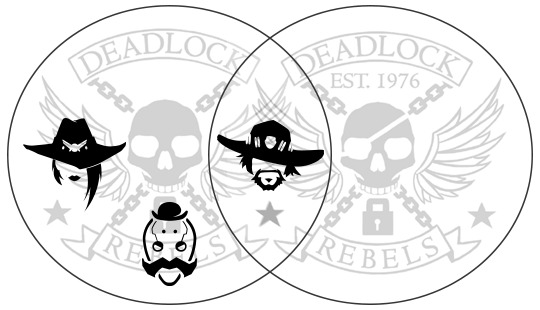
Here’s a tinfoil hat theory: Deadlock Rebels the Gang founded by Ashe and McCree is a different entity from the Deadlock Rebels established 1976.
The TL;DR:
There are two versions of the logo—the eyepatch-less version we see on Ashe for the Gang and the eyepatched version we see on McCree for the Rebels. This is why the eyepatched version only ever appears on McCree. Strangely enough, the eyepatched version actually makes a comeback after Ashe’s reveal, rather than disappearing as many expected.
In addition, the in-universe and real-world verbiage around Deadlock very consistently exclusively refers to them as “Deadlock Gang” instead of as “Deadlock Rebels” per the wording in their logo. The only time “Deadlock Rebels” appears in a minor usage for a player icon, it is actually attached to the eyepatched version of the logo.
With this, it’s possible there is a suggestion that there are two Deadlock groups and that McCree was a member of the Deadlock Rebels established in 1976 before he went on to found the Deadlock Gang with Ashe.
Ground Rules
This post assumes that this mixture of logos is intentional. It is absolutely possible that it is simply originally an error made when John Polidora referenced old concept art instead of the updated live version (more on that later) or that it is simply a retcon—and that corrections on this mistake or retcon have been implied inconsistently for whatever reason.
I am not absolutely ruling out that it is a mistake or recton. It is very deeply possible this is just the most inconsistent imagery.
I am simply trying to propose an alternative theory to that.
For the purposes of this post, and to keep things as clear as possible, "Deadlock Rebels” (or, the Rebels) will only refer to this hypothetical non-criminal motorcycle club established in 1976 and “Deadlock Gang” (or, the Gang) will refer to the group founded in roughly 2056 by Ashe, McCree, and two unnamed others. Simply “Deadlock” does not refer to either group and is used in contexts where I don’t want to refer to specifically one or the other.
Branding History
First, a timeline of the various Deadlock logos just to establish the different versions and how we got here.
During development of the Route 66 map, the design team went through a number of iterations of the logo. The Art of Overwatch shows two iterations:
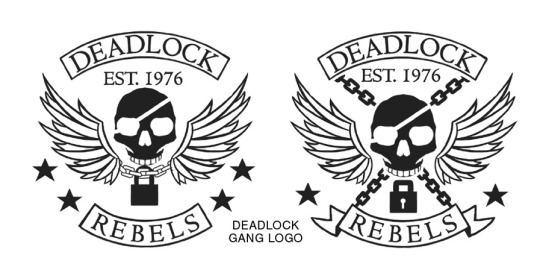
[Portion of a page from The Art of Overwatch showing two variations of the Deadlock logo.]
The one we’re interested in is the one on the right, which is more similar to the version we see most often—but more on that later. This version of the logo notably features an element stating “est. 1976″ and has an eyepatch over its right eye (our left).
The version featured repeatedly on the Route 66 map, the logo’s first canonical appearances, is slightly different.
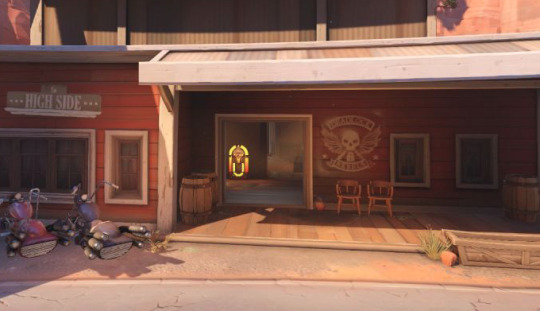
[Screenshot of the Route 66 map during the Overwatch beta, showing the Deadlock logo sprayed on the front of The High Side saloon.]
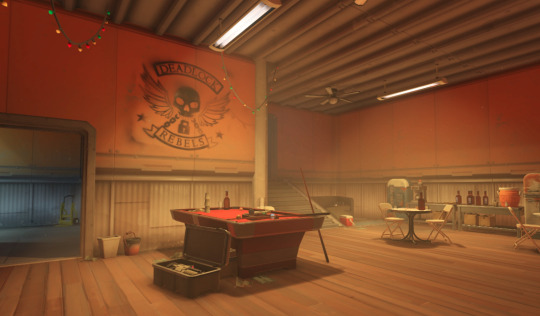
[Screenshot of the live Route 66 map, showing the Deadlock logo sprayed on the wall inside the Deadlock Gang hideout.]
The logo that appears on the Route 66 map lacks the “est. 1976″ element and is eyepatch-less. (It also has two less chains, but that isn’t important. I consider that to be a negligible variance, even though it does vary.)
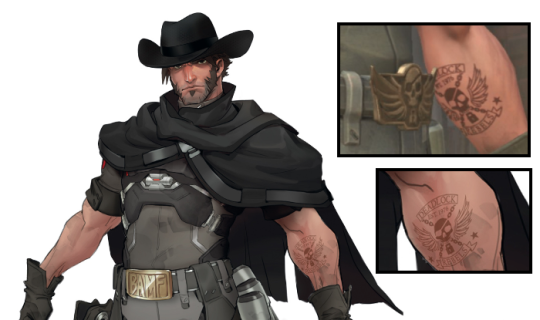
[Concept art of Blackwatch McCree by John Polidora as seen in The Art of Overwatch. Insets are of the tattoo from the concept art and of the tattoo and belt buckle from the live skin.]
The Deadlock logo appeared again on the Blackwatch McCree skin for Uprising Archives. The skin features the eyepatch version of the logo both on his belt buckle and on his tattoo, which also features the “est. 1976″ element. This is the first time the 1976 version of the logo appears in the canon. The concept art for the skin, by John Polidora, shows the eyepatched version of the logo, though only on the tattoo and not the belt.
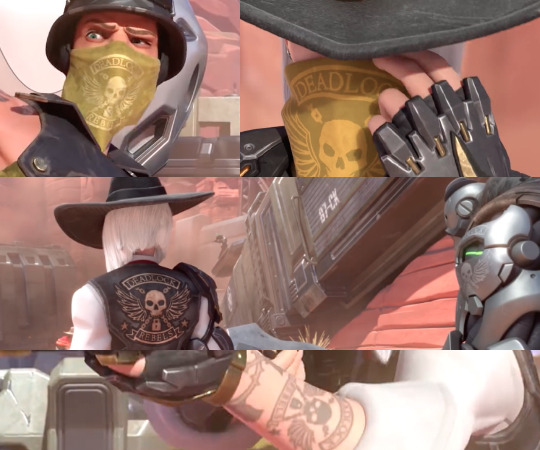
[Screencaptures from “Reunion” of two bandanas, the back of Ashe’s jacket, the engraving on BOB’s arm, and Ashe’s tattoo.]
“Reunion” introduced members of Deadlock Gang other than McCree, and with that, many more instances of the logo. The logo worn by all members of Deadlock Gang—on bandanas, jackets, engravings, tattoos—are the version appearing on the Route 66 map: the version without the “est. 1976″ and without the eyepatch. (Again, these versions tend to have four chains, while the map logo has only two, but I believe that it’s literally the same logo and such difference is negligible.)
I do not have screenshots handy, but this is the version of the logo used in-game on Ashe and BOB.
At this point, it was assumed that either Team 4 retconned the “est. 1976″ portion to make room for Ashe and McCree founding Deadlock Gang when they were younger or that Polidora made a mistake when designing the skin and referenced an old, scrapped version of the logo rather than the finalized live version.
However, for Storm Rising Archives, the Deadlock McCree skin was revealed.
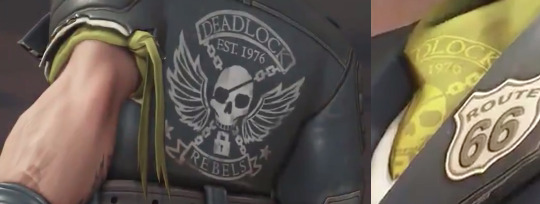
[Screenshots from the Deadlock McCree reveal trailer showing the eyepatched Deadlock logo on the back of his jacket and on his bandana.]
This skin, like Blackwatch McCree, features the “est. 1976″ and an eyepatch in every single place possible: his jacket, his tattoo, his bandana, his belt buckle, his gun. This logo makes a return despite the establishment date it cites being contradicted by the previous reveal that Ashe and McCree founded Deadlock Gang.
At this point, disregarding the number of chains in the logos, we have two major variations of the Deadlock logo being used more than once in the canon.
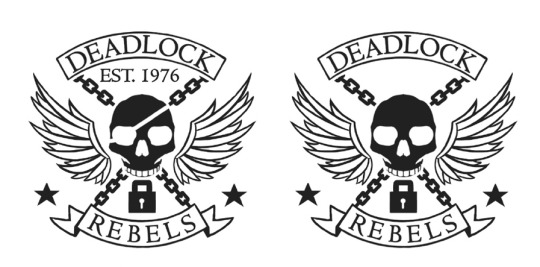
[Images of the two Deadlock logos: one eyepatched and with the “est. 1976″ date, the other eyepatch-less and with no displayed date.]
Watch Your Language
All verbiage surrounding the group founded by Ashe and McCree exclusively refers to them as Deadlock Gang. Not once in the entire What’s Next panel at Blizzcon 2018 are they referred to as the Deadlock Rebels.
But amid the fading monuments of that earlier era, the outlaws of the Deadlock Gang are planning their biggest heist yet. [Official description of Route 66 map]
McCree had already made a name for himself as a member of the notorious Deadlock Gang... [Official McCree Bio]
Affiliation: Deadlock Gang
Ashe is the ambitious and calculating leader of the Deadlock Gang and a respected figure in the criminal underworld. [...] Along with the other three founders of the Deadlock Gang, Ashe started to make a name for herself with bigger and more extravagant heists. The Deadlock Gang’s rapid rise to prominence... [Official Ashe Bio]
Ashe is the leader of the Deadlock Gang, a group of bandits and criminals who menace the American southwest [Ashe gallery description]
In their younger days, Jesse McCree and Elizabeth “Calamity” Ashe co-founded the Deadlock Gang. [Deadlock McCree gallery description]
Courtesy of the Deadlock Gang. [Ashe elimination line]
Deadlock Gang must’ve wanted it bad. [former McCree Route 66 line, now removed]
Reyes should've cleaned up the Deadlock Gang a long time ago. [Soldier: 76 Route 66 line]
One goal of Route 66 was establishing the Deadlock Gang. [The Art of Overwatch]
Even down to Ashe’s cosmetics. The one time the “Rebels” verbiage comes close to being used in reference to Deadlock Gang is as the name of one of her sprays. There is a player icon associated with her that is named “Deadlock Rebels” but this icon uses the eyepatched version of the logo rather than the eyepatch-less version actually associated with her.
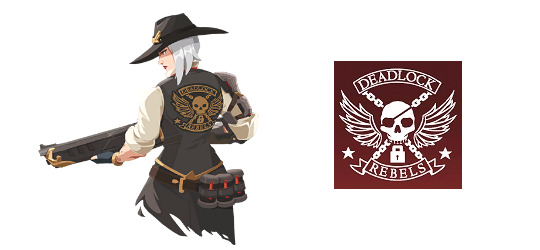
[Left, Ashe’s “Rebels” spray. Right, the “Deadlock Rebels” player icon.]
To continue digging, when Deadlock is mentioned in the teaser ahead of the McCree reveal, the group is mentioned as having a biker rally, but they are referred to simply as “Deadlock” with neither “Rebels” or “Gang” attached to them.
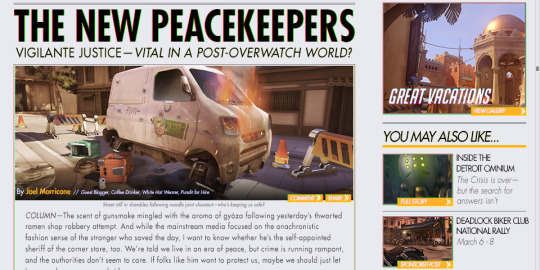
[The teaser released ahead of the McCree reveal. Deadlock is mentioned in the lower right hand corner: “Deadlock Biker Club National Rally”]
It’s worth mentioning that the Artbook captions the concepts for the Deadlock logo as “Deadlock Gang logo”, both of which are variations of the eyepatched logo. However, I consider this non-issue, as it’s like captioning the much more Egyptian-inspired Zenyatta concepts as “Zenyatta”. And, being it isn’t an in-universe verbiage, it carries lesser weight.
But... why call them exclusively the Deadlock Gang when their logo states Deadlock Rebels? Isn’t that unnecessarily complicated?
Tinfoil Cowboy Hats
This is a really tiny point, it’s also strange that McCree is seen wearing what appears to be the Deadlock Gang bandana—at the exact moment that Deadlock Gang is founded, so he would’ve owned the bandana before the Gang existed. His Deadlock skin, after all, shows him wearing the bandana with the eyepatched version of the logo—and the same hat, though I imagine he keeps that hat for a long time after.
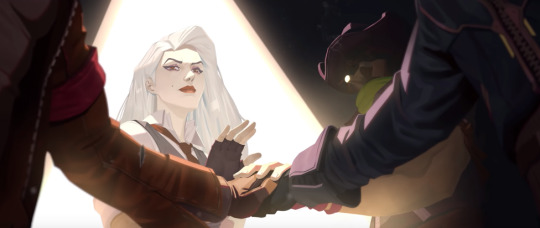
[Screenshot from Ashe’s Origin Story, depicting the moment of Deadlock Gang’s founding between Ashe, McCree, and two others.]
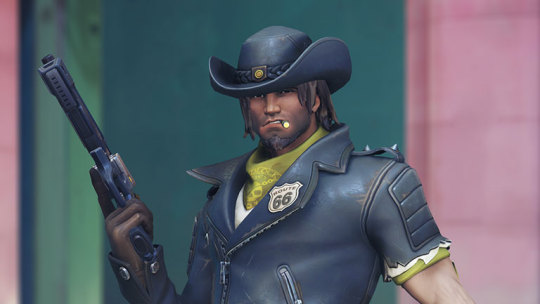
[McCree’s Deadlock skin.]
There’s a lot of explanations for why these repetition of elements: the short already establishes Deadlock wears yellow bandanas, the skin’s design is pulling from Ashe’s Origin video. But, I’m tinfoiling.
On tinfoil notes from Ashe’s Origin video, the Viper rifle is seen hanging on the wall when she is a child, and it displays the Deadlock logo.
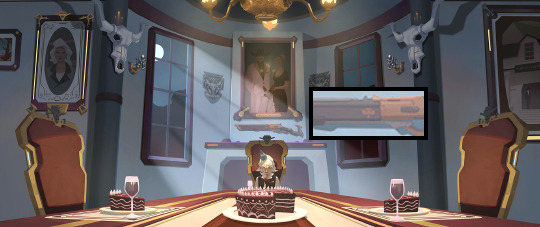
[High quality still of Ashe’s Origin story from Nesskain.]
Again, there are alternative explanations for this: the gun was referenced off her final model, which has the logo on it. It reflects the reference used irrespective of timeline rather than suggesting than the logo existed before Ashe founded Deadlock Gang.
However, I’m weaving tinfoil hat theory here.
99% of Motorcyclists—And The Remaining 1%
So, if I’m searching for answers other than an inconsistent retcon, what explanation am I offering? I suggested this in November after the Ashe reveal, and I alluded to it even earlier, but: suppose there were two very separate, even contemporaneous groups using the name Deadlock Rebels?
The Deadlock Rebels Biker Club is established in 1976, and it designs for itself a logo of a eyepatched winged skull. Decades later, a young Jesse McCree is a member of this group.
Maybe he’s in it because he’d fallen in with them after the Crisis. Maybe it’s because his family historically is a member of the Rebels. I do not know. Possibly, the Deadlock Rebels are also one-percenter, and it is through this group that McCree establishes himself as a “budding miscreant” (to quote the What’s Next 2018) and “local ruffian”.
He goes on to form a partnership with Ashe, arguably leaving the Deadlock Rebels, and together with two others they found the Deadlock Gang. They adopt for themselves the same iconography with slight changes—they drop the eyepatch and the “est. 1976″ flair—and they operate out of Deadlock Gorge just like the Deadlock Rebels.
However, McCree, having been a member of the Deadlock Rebels, already has the eyepatched version in his tattoo and on his clothing. So, for pragmatic reasons, and because tattoos are not easily changed, he continues to display this version.
It forms a sort of arc for McCree where is he constantly leaving one group to go to another because “he can do better”: from the Rebels to the Gang, from the Gang to Blackwatch. McCree has a running theme of being “far from home” and of moving right along through life, constantly leaving groups and found families. (His new Archives line well illustrates this: “I ain’t gathering no moss.” He keeps moving on and moving on and moving on.)
Arguably, this might also explain why Reyes had a difficult time clearing out Deadlock Gang. Ashe, McCree, and their cohorts were using their similarity and tenuous connection to the Deadlock Rebels as a way to cover their tracks and misdirection their activities onto the other group. This line of argument does not feel strong, but it is tenuously possible.
A Matter of Historical Record
Overall, it isn’t uncommon for outlaw gangs in the West to share the same name. If they weren’t named for their leaders, they were often named after geographic regions. The most famous example is the Hole-in-the-Wall Gang, which is actually a coalition of several gangs who all used the Hole-in-the-Wall Pass, Wyoming as a hideout but largely stayed out of each other’s business and adhered to a system of rules to maintain the peace within the Pass.
This should sound familiar. The story point of Ashe forming a coalition between the Southwestern Gangs to put an end to their in-fighting and adhere to a system of rules to keep things civil between them was probably inspired by the Hole-in-the-Wall Gang.
In slight variation to what I described above, it’s actually possible McCree’s agreement to found Deadlock Gang with Ashe and the two others saw the Rebels absorbed into the Gang, but the name was kept because simply that’s what gangs operating out of Deadlock Gorge are called: the Deadlock Rebels, synonymous with the Deadlock Gang. This second iteration of Deadlock redesigned elements of the branding to represent this new coalition between the four of them (and possibly whatever other gangs the two others may have represented), but McCree continues to display the old logos in significance of his membership in the first iteration.
Which version is more likely, that both groups continue to exist distinctly different forms or that they two groups are now closely tied together as a result of the agreement between McCree and Ashe, I am unsure at this time. Whether or not it materially matters is another thing entirely.
The important point here is that there are, or were, two Deadlocks that existed close in time and McCree was part of the other one before he founded the 2056 iteration.
In Summary
There is a very long history of the Deadlock logo, and for some reason, the logos McCree displays differs significantly from the logos Ashe, Bob, Route 66, and the others display. It’s odd, given that the “est. 1976″ date displayed by McCree directly contradicts that he and Ashe founded the group circa 2056.
However, notably, the verbiage surrounding the group founded by Ashe and McCree exclusively refers to them as “Deadlock Gang” rather than “Deadlock Rebels” per the logo. It’s almost stunningly consistent in how the group is literally never called the Deadlock Rebels. In fact, the only reference to a “Deadlock Rebels” is to an eyepatched version of the logo, the one McCree displays.
Given historical record, the commonality of Old West gangs to have similar names due to shared geography, and McCree’s own thematic arc, what if there was two Deadlocks: the Deadlock founded in 1976 and the Deadlock founded in 2056—and they both count McCree as a member. Due to being part of the 1976 group first, McCree acquired their logo first, and he continues to display it for that reason.
#Jesse McCree#Overwatch#Gena plays Overwatch#long post for ts#watch me have to make EIGHTY BILLION EDITS TO THIS
32 notes
·
View notes
Text
Gonna write my scatterbrained Spicy Hot Takes on Agartha before the news is stale and I delete this annoying and boring chapter from my mental landscape, so bear with me:
I think Agartha’s main issue was just straight up poor writing. The Japanese direct translations being as downright offensive as they were is one thing - but overall, the chapter is just one plot contrivance after another. It tries so, so hard to go for a certain tone but can’t seem to stick to any one thing or idea. Disregarding themes about sexuality probably would have been the very best way to go about this chapter, since I think the most interesting part was the theme about storytelling and in-authenticity - we all know that That Line was annoying af in a game like FGO, but it CAN work in a series like Fate as a whole. I had a helluva long day at work so allow me to explain in the least scatter-brained way I can manage right now:
Here’s what I’m thinking: Scheherazade, whose name I guarantee I will spell wrong/differently every time I write it even though I’ve been able to pronounce it properly since I was thirteen (I was in a speaking competition and told some of the Thousand and One Nights using her framework as the opening monologue, long story short ANYWAY -) is traumatized by her ordeal with the king. This is a really good and interesting thing to explore! Fitting it in with the theme of storytelling - Scheherazade is deeply afraid of dying and will do whatever it takes to live, so she makes a fantasy world and fills it with legends, and feeds their energy to a Holy Grail. With this, and the power of a Demon God at her side, she plans to reveal magic to the human world in the most destructive fashion possible, allowing the fantastic to become ordinary, and destroying the Throne of Heroes itself in the process. Fate is a series were stories have power - but Scheherazade survived basically by telling the most fantastical, interesting tales she could and never finishing them. She always would pause in the middle, and say, “That’s all for tonight.” I think this is the kind of thing we can run with in terms of setting.
Dahut is the weirdest example because it’s the one story in the chapter that I know next to nothing about. At one point it’s mentioned that Dahut is impossible to summon as a Servant, and so Drake was “forced” into the role of the Pirate Princess. Ys is probably the weakest part of the chapter for that, but I did like the idea of her being “Drake Alter,” where Drake vibrantly pursues her goals and desires but takes nothing for granted; Dahut gives into her every whim and takes absolutely everything for granted. The conflict between “Drake” and “Dahut” should have been emphasized more instead of having the player/Da Vinci dismiss her as “Oh, it’s not Drake, except when she conveniently comes back to delivery us the MacGuffins Ex Machina in the eleventh hour.” Dahut has little connection to Drake - it’s not her story, but a role she was forced into because Scheherazade was building a very specific kind of world. Therefore it is inauthentic. Perhaps that’s all it needs to be in this context.
This can also work with the Amazons. Scheherazade never told stories of the Amazons, but she has access to basically all stories in the world through her Noble Phantasm - she learns that they are a society of warrior women who live without men, and so decides that they will be a society which oppresses men due to her fear/bitterness towards men after the ordeal she suffered through. The “oppressing men” plotline was honestly dumb all around but using the Amazons as a mechanism to explore Scheherazade's trauma would’ve been more interesting than just having them be the Big Bad before the Big Bad Columbus Reveal: Scheherazade doesn’t like fighting, but wishes that she had been strong enough to protect herself. Because she views herself as a coward and her ordeal with the king has complicated her view of sexuality - “I’m better suited to a bedchamber than a battlefield” - she uses the Amazons of Agartha as a mechanism to cope.
This brings us to Wu, whose design I’m still not happy about even though I think the in-story justification is somewhat fair. (Let Helena and Wu be gray-haired grannies together or so help me!) Wu was absolutely an authoritarian ruler who did, in fact, invade and conquer several nations and institute a terrifying network of secret police. In her later life, she was given to decadence - but her tenure on the throne showed her to be a highly competent administrator. Notably, she ruled over an era of religious tension and balanced matters quite well, and though she was accused of undoing meritocracy to put her supporters into power, many of the men she appointed held positions in government long after she’d died because they were actually good at their jobs. Wu has been heavily mythologized over the years - later Tang emperors and Neo-Confucian scholars wrote her off (Wu founded her own dynasty under her own name, so they kind of had to legitimize it somehow), she became associated the nine-tailed fox spirit thanks to a few popular novels and poems, etc., etc., etc. The crazy thing is that Wu actually left very few records of herself behind, apart from some poems. Even the inscription on her tomb is blank! People can say whatever they want about her - it’s extremely difficult to know the full truth of the matter without any objective observers in the field (and without Wu’s own words to give context/another story), especially if you don’t read any Chinese.
BTW - the first thing I learned history class is that when you’re dealing with primary sources, you must always remember that translators have agendas. Every word is a deliberate choice, and it changes the meaning from the original text. When dealing with historical documents, this is not always a good thing.
Scheherazade reads some, but not all of these stories, and integrates Wu into her world as the sadist empress with an iron grip on her decadent mythical city.
Do you see what I’m getting at here? It’s a lot, but I’m not done. Now we have to deal with Columbus - there’s “In Defense of Columbus” video is floating around in the Agartha tag, but I haven’t watched it in full and haven’t done like, any intensive research on Columbus in particular, so I’m going to apologize right now for any historical inaccuracies/misconceptions that I’m about to write. The point I want to make here mainly is that Columbus, like Wu, has been heavily, heavily mythologized for both good and evil at various points. The thing about Columbus that is also interesting is that the authenticity of his journals is or was apparently a subject of debate. The man who published most of them actually happened to be Bartolomew de las Casas - one of the founders/first vocal supporters of the Trans-Atlantic Slave Trade. The reason de la Casas supported this is because he believed that using African labor would be an improvement over enslaving the native populations of the New World. Soon after, he had a change of heart and devoted the rest of his life to fighting against slavery in all forms. De la Casas went on to be named a saint, and was possibly the first person in history to propose the idea of universal human rights - which is how I had heard of him until literally just this afternoon; I had no idea he’d ever supported the slave trade until I was looking up basic info about Columbus’s writings so I could write this long-ass post. History is full of complicated people.
But as I mentioned in Wu’s bit, it’s very important to note that in many ways, Columbus is literally just whatever people decide he is. Like, he never even set foot in any land that would become the United States, and yet he’s a huge symbol here! Along these lines, his amnesia would fit the theme of inauthentic storytelling, choosing what to read and what to believe in. Columbus regaining his memories was an understated moment, which is actually fucking fantastic because it could be used to really emphasize the choice that is being made here. He’s a Heroic Spirit who can choose to be whatever he wants. He can choose to be the simple hero-explorer that schoolchildren sing about, or he can choose to be the Big Bad, the first and perhaps most infamous conquistador. And he chooses to be the bad guy. That is so fuckin’ fantastic, y’all! I honest to God love that not only did FGO portray Columbus as a villain of history but that the bad reputation is something he chooses to maintain! I can write a list of Servants who were less than stellar people and got a makeover for Fate. Nero is probably one of the worst examples but like - Ozymandias absolutely owned slaves in his life as a pharaoh. Hercules and Medea murdered their own children. Asterios literally ate humans as the Minotaur. Gilles de Rais exists as a playable character. Jack the Ripper is your daughter. Hell, Nobunaga burned temples with the monks still inside - but she feels bad about it now! Enough digressing but I a hundred percent get why Japanese fans found Columbus “refreshing” at his introduction. He owns his cruelty, his desire to exploit others - he challenges the narrative that everyone is redeemable because he doesn’t even want to be redeemed, he just wants to get rich and famous, and he doesn’t give a shit who he steps over in the process! Like, Columbus said, “I’m just doing what comes naturally,” at one point when he still had amnesia, so when he got his memory back and turned on the player, I really would’ve liked for him to say is something like, “You’ve already decided that I’m the bad guy, right? You know my story, and I’m nothing if not a man of my word.”
These kinds of questions/debates could have been used to emphasize the themes of Agartha. Legends are what people decide they are. People make choices and history decides whether they were good or evil or important retroactively. Can you know what someone is like by reading a translation of their poetry? Can you judge a king’s reign by the words of their successors or their rivals? Does the context of a story matter? This all could have been super interesting to explore!
Like I said, the main theme of Agartha being “inauthentic storytelling” could have been hella, hella good considering that this is a world created by Scheherazade’s fears and trauma feeding into her escapist desires. But Minase’s incompetence as a writer made everything so hamfisted and awkward that everything just suffered under his desire to insert his fetishes at every moment. It was so obvious that he didn’t read any material for old Fate characters - like Astolfo you poor sweet thing, you deserved so much better! - and even the new characters that he clearly did research on, like Columbus, fell flat because he couldn’t figure out what he was trying to say beyond mildly-to-extra offensive sex jokes.
#i'm tired so i may not reply to any responses but i had to get this out of my system because it's been nagging at me#like... it could've been good#it could've been at least decent if minase just... knew how to deal with a theme and read up on some fate character materials#but he didn't do that and so now we have This Mess#fate grand order#agartha nonsense#also disclaimer i did the baaaare minimum of research for parts and didn't even dig up my Empress Wu Research Paper docs#but like now that i've got this off my chest i'm gonna be done wasting time thinking about agartha since it was just so....#not even like that it was especially bad it was just... lifeless and insipid#thank goodness holmes told us it wasn't even canon lmao
7 notes
·
View notes
Text
inside the mind of gukyi

recently, i’ve been getting a lot of asks asking me for writing tips/advice/my process, so i figured i’d save everyone some time and make this post to answer your questions! if you still want to ask me about writing and have any specific inquiries, feel free to send them my way!
i am not a professional writer and these are not professional tips. i’m still a student and have lots to learn; in no way can this be considered complete. this is merely my process, how i write, and what i’ve learned over the past several years as i’ve explored the creative writing field both on and off tumblr.
this is a really, really long post. as you all probably know, i’m an extremely wordy person, and there is certainly no shortage of words in this. but i figured that if you guys can read a 50k jungkook fake dating fic, you guys can read this.
HOW I GET STARTED
i know that that blank, white word document seems insurmountable and daunting. i’m telling you right now, it’s not.
where my inspo comes from:
anywhere. i find inspiration in everything, i look at my life and the world around me and think “how can i write a fic about this?”. earnestly yours was inspired by a story told to my friends and i by the drama club director. moonlight melody was inspired by the time i went to florence over the summer and saw a student orchestra from germany perform in palazzo vecchio. the underwear thief was inspired by my dad’s own cat when he was a student. it’s ridiculous to say, but i am constantly thinking of new ideas to write. i have several unwritten ones floating around in my head right now.
when my thoughts are particularly dry or i just need to refresh, i’ll do this ask game where i ask you for a fic title and i will have to come up with a story. more often than not it will produce some fantastic prompts for me to work off of. this is how dirt and glitter galore will come to be.
how i turn that inspo into a story:
okay, i have an idea in my head. let’s take moonlight melody, for example. i saw the student orchestra perform and then i wanted to write a fic about it. so, without writing anything down, i started to think about what kind of fic it would be. would my characters be orchestra students? would the two leads be friends? enemies? strangers? how would they fall in love? where would they go? what would they do? what obstacles would they face?
i don’t need to answer all of these questions. all i need to do is to pick an alternate universe to place my characters into and pick a trope, and i’m off. for moonlight melody, i actually jumped through two other ideas before settling on what it is now. originally, it was a friends to lovers/acquaintances to lovers fic between two students on a school trip to italy. then, it become an enemies to lovers fic between the two warring top members of the orchestra. finally, it was a fake dating au to get revenge on the oc’s trickster of a best friend.

HOW I MAKE A PLOT
i have the idea. i have the au. i have the trope. now, i need to figure out how to get from point a to point b.
planning... sort of:
if you’ve been following me even for 5 minutes you probably know that i plan out probably about 2% of my fics. those fics are ice prince and the truth between us. those are genuinely the only two fics i have planned from start to finish before i even wrote down a single word of the fic. the rest of my fics have been lightly planned at best and were mostly the product of me making stuff up as i go.
i know that a lot of writers on tumblr like to plan out their fics ahead of time, which is honestly the less-chaotic way to go about it. almost every time i attempt to do this, i bail on the fic, so it’s clearly not my forte.
instead, i divide my “plan” of action into three parts: the inciting incident, the climax, and the resolution. i decide what is going to propel the plot forward, where the peak of the action and the emotion is going to be, and what the end goal is. this is really all i need to write a fic, because i can fill the blank spaces between each major part of the story with little scenes that will slowly snowball into the climax, and then the conclusion. these blank spaces are typically known as the rising and falling action.
so you don’t plan anything????
though these rising and falling action scenes are typically made up on the spot, once i have an idea of what’s going to happen in each individual scene, i will make a very brief bullet point that tells me how to go about it. taking moonlight melody again, i knew that the inciting incident would be hoseok stealing oc’s headphones as another prank, the climax would be the day that jungkook confessed, and the resolution would be the flight home. the scenes in the middle were wholly unplanned, though, to ensure that i wouldn’t forget anything, i had bullet points at the bottom of the document that looked like this:
gondola tour in venice (seokjin, hoseok, jungkook, oc)
they all go drinking
jungkook nearly confesses to oc but instead just throws up
brief, but the point is there. this is typically how i go about all of my fics. the main three parts are fleshed out but everything else is spontaneously thought of.

HOW I MAKE A CHARACTER
plots are pointless if your characters are boring.
creating a character bio:
these aren’t so much bios as they are background information. characters need context for existing so that the plot can move forward. i almost never write out little plans for my individual characters since this information i can typically remember, but if you can’t or if you think fleshing out your characters on paper is easier, by all means. my bios (in my head) consist of qualities and characteristics that are either 1) inalienable (meaning that they don’t change throughout the course of the fic) or 2) very present at the beginning of the fic but may change over time. to me, the character bios are how i view the character at the start of the fic, rather than the end.
this can include stuff like hobbies, occupation, and qualities. for jungkook from moonlight melody, it would look something like this:
photographer
best underclassman violinist
reserved but comes out of his shell around friends
supports taehyung’s antics
had a crush on oc for ages
general fine arts hoe
if you’re a fic writer, feel free to base your characters off of the traits they possess in real life/canon-ly, but also don’t be afraid to give their personalities a makeover. they should fit with your fic. you don’t need to retain their original traits just for your writing.
developing my characters:
this i almost always keep reserved for main characters only. all of my quirky best friends in my fics are flat (meaning they don’t have any character development) just because they typically function as comic relief and don’t need to have some big character arch to be important.
character development is how my characters go from enemies to lovers and friends to lovers because obviously, to go from such polar opposites, something has to change. quite frankly i’m not the best at character development but one thing i make sure about is that it’s subtle. it’s really, really unnatural for characters who have been enemies for their entire lives to suddenly just Up And Kiss like it’s nobody’s business. there has to be a slow shift because before they can be lovers, they have to be friends. subtlety is key. i’m still working on my character development skills because i don’t think they’re that hot.
making my characters realistic:
this is my favorite, favorite part of writing. favorite. i love it because i get to throw in all these dumbass quirks to make the characters fun and relatable and not boring masses of dialogue. this is the part where i get especially creative, because there are just so many things that make people tick. i throw in random traits and characteristics like “raw corn allergy” or “aspires to be instagram famous” or “frequently quotes vines for no apparent reason” because people in real life are like this. they aren’t robots, machines with the same general makeup but slight variations. everyone’s different.
in a more serious sense, this also applies to traits that are generally less favorable to society, even if they aren’t in the grand scheme of things. jungkook from the underwear thief regularly wishes for a black hole to suck him up and remove him from reality. the oc in start anew fears her own past and clings to it at the same time. broken rings & queens and kings’ oc often lets her pride get the better of her.
these characteristics make characters human, which in turn makes them relatable, which i think adds to the charm of my writing, because people feel like they’re kin with the characters they’re reading about.

HOW TO WRITE DIALOGUE
i have a couple answered asks about writing dialogue: this one about using dialogue to start a story and this one about how to make dialogue seem natural and this one about how to use dialogue to propel a story rather than prose. dialogue is another one of my favorite parts about writing, and i would generally consider myself a dialogue writer rather than a description writer.
i write dialogue by listening to how people speak. this can be in any context, from people in real life to movies and tv shows to youtube videos. every now and then i will just take out my headphones and listen to other people talk, their mannerisms, they way they conduct themselves through their voices. then, i will take that and apply it to my own characters. granted, i embellish my characters’ speaking patterns slightly because obviously i want my characters to be more exciting that the people i know in real life, but the basis is the same.
colloquialism and vernacular plays a big part in this. people don’t speak like they write research papers. at least, i don’t. even as i write this, this is how i would be speaking if i were telling you all of this information in person rather than typing it out and posting it. i almost always write how i speak. it’s just the kind of language that flows most naturally to me. so, in my fics, i make sure to use slang words and abbreviations and whatnot because that is how i speak regularly and that is how other people around me speak as well.
when i say embellish, i sort of mean making them sound cooler than the people you know in real life. ain’t nobody who i speak to on a regular basis saying cool analogies and figurative language. that’s the part that i typically embellish. for example, jungkook in the underwear thief tells taehyung, “i’m gonna have to wash these again just because you put your blackhead-filled nose up to it.” now, i have never heard the phrase “blackhead-filled nose” uttered before in my life. but i made jungkook say it as an embellishment on his already realistic speaking patterns.
one thing that i was asked to include is how to vary action words after dialogue to make the story seem less “he said she said” and more professional. i’m guilty of doing the “he said she said” thing a bunch, which is apparently a big writing no-no, but jk rowling also has a habit of doing it so take from that what you will. generally, i like to stick to a couple of main action verbs that explain emotions like “furrowed brows” (represents confusion) or “sighs” (resignation) or “groans/complains” (annoyance). or, i’ll just go straight into an action verb that doesn’t have anything to do with speaking, like “smirks” or “rolls eyes” or something like that.

HOW I STAY MOTIVATED AND PRODUCTIVE
this is a misleading subtitle because i am, on a regular basis, neither motivated nor productive.
motivation and other elusive social concepts:
the only thing i can vouch for concerning motivation is that if you aren’t enjoying what you write, stop writing it. it’s that simple, really. i have a lot of wips that will die along with the end of the earth without anybody besides myself seeing them because i got to a point in the fic where i just wasn’t enjoying myself anymore. above everything else, when i write i want to be having fun. it’s a goddamn hobby and it shouldn’t be a chore. i find peace of mind when i write, and so i will continue to do it.
reading also helps a lot. i typically try to read, whether it be fic or an actual published novel, every single night. if i am reading something that i am especially enjoying or that i find just... genuinely outstanding, then i’m more inclined to want to work on my own thing because holy shit, that thing i just read was so good i want to do that.
productivity? never heard of her:
you may or may not be familiar with the fact that the majority of moving on was written between the hours of 12am to 7am the day it was going to be posted, with a 3 hour nap during that time period. don’t do that.
i try to write for at least an hour or two every night, but the key word here is try. if i’m particularly busy or just not feeling up to it, i won’t. it’s really no big deal. a lot of the times my productivity will go up and down like the wall street stocks with most of it occurring closer to the time i want the fic to be posted. on those days, i set myself mildly strict guidelines for writing time and try to get as much of it done as possible. i know that i can write about 1k an hour, but if i’m really in The Mood then i can write 1k in 30 minutes.

MY UNCONVENTIONAL (OR CONVENTIONAL) HABITS
i write best when it’s dark outside, and some of my finest work is produced roughly at 2am. i will listen to the same song over and over and over if it’s the only inspo i can find for a fic (i’m looking at you, moonlight melody). my writing spaces have to be neat, whether they be my desk or my bed. i always try to have water with me because stay hydrated, folks! i check my word count like every five minutes even if i haven’t written anything. if i’m not feeling inspired for a fic i will typically turn to tumblr to see if you guys can elicit some sort of inspo for the fic, either by asking you guys to ask me questions about my fic or working on a wips page. my word count estimates are either right on target or gross underestimates. i have a habit of repeating opening clauses for effect, typically three times right after each other.

ANSWERING YOUR QUESTIONS
hopefully most of the things you guys were looking for were already answered, but i did get some requests for more targeted answers. bear in mind, this is just how i would go about doing these things, so you can do whatever you want with this information!
how to structure sentences and make sure they’re the right length:
try to mix long sentences and short sentences together. a line of dialogue doesn’t need be accompanied by a big paragraph all the time. you can often just make a new paragraph right after the quote; you don’t even need an action verb. balance out your sentences. if you have a long paragraph with long sentences, make the next line a couple of words.
how to make a sfw fic interesting:
i’ve said it before and i’ll say it again: a fic does not need smut to be interesting. not everything needs to be sexual in nature. when you think about it, most books aren’t sexual in nature, and there are plenty of interesting ones out there. alongside the plot, what makes a story really interesting are the characters. see the character section above for how i try to keep my characters fun and lovable.
how to write smooth sentences/have flow:
one rule of thumb i always try to follow is to not have each new paragraph start with the same word. there are plenty of ways to start a new paragraph with a word other than “you” or “then” or “so” and it makes your writing interesting and diverse. to have flow, try to find cadence in your writing. a rhythm, perhaps. read your sentences back to yourself. it should flow smoothly on your tongue and the words should come to you naturally without any thinking at all. if you want to change topics, do so slowly. don’t try and pull 180 turns with your writing, it’s abrupt and unnecessary.
how to be detailed:
figurative language. that’s it. any type of figurative language. rhetorical devices work, too (here’s a great list). figurative language is the spice of writing. try to use metaphors, similes, analogies, and allusions that are relevant to the time period in which your story is set.
alongside this, try and think about everything that your character is doing during that scene or that dialogue, and not just their face. think about how the world is interacting with them. are they nursing a cup of coffee? tapping their feet? is the wind blowing their hair slightly? see your characters as people and not just faces.
how to title:
ugh, titles, my nemesis. i title all of my fics after i write them because when i’m finished with the fic, i’ve got a pretty good grasp as to where the story is headed and can name it accordingly. some tips for titling are to find those cool word blogs/sites and snatch up a word from there that seems to match or think of a common phrase/idiom/whatever that matches your fic and either use it or alter it slightly. quite honestly though, most of my titles come straight out of my ass.

HOW TO NAVIGATE THE BTS WRITING COMMUNITY
bear in mind that this is just how i have personally experienced the community while writing here on tumblr and that this is not representative of everyone’s experiences. also these are mostly just tips so you are under no obligation to take my advice or believe what i say!
if you are an sfw writer/uncomfortable with writing smut, cool. that’s cool. that is so cool because me too. i know that the pattern on tumblr is that nsfw fics get hella press and everyone else is left in the dust, and this may cause you to feel the need to include smut in your fic to gain notes but please, don’t. don’t do it. it’s not worth it because you should always 100% be comfortable with what you are writing. do not let other people determine your writing (unless you are writing something distasteful in which case um, maybe stop that?).
writing should not be a chore. do not let people on tumblr, whether they are your followers or not, pressure you into thinking/feeling otherwise. you are doing this for free. you are getting nothing in return except for notes on a social media website. you do not owe anybody anything.
there is no secret sauce for becoming a quote unquote “popular” blog. popularity is overrated anyway and quite frankly any decent human being on this website, even if they have 100k followers, will tell you the same thing. it’s all a hoax. write what you love and love what you write and people will find your blog. readers can tell when your heart isn’t in it. don’t let the numbers get to your head because they’re almost pointless.
be a nice person? people like nice people? it’s pretty self explanatory. here’s the thing. you don’t owe your followers anything but they don’t owe you anything either. don’t treat them as such. they aren’t less than you because you write and they do not. love and respect your followers because they will do the same to you.

HOW TO WRITE LIKE A WRITER
write. write write write write write. don’t stop. even if it takes you months, years to write. do it.

i hope this was helpful!! i could probably go on and on for a million years about each of my quirks and habits when it comes to writing, but i wanted to make sure that you guys finished reading this thing before the turn of the next century. i also have a tag on my blog called #writing tips where i answer some questions a little more specifically, though there may be some repeated information just because my process hasn’t changed all that much. as always, message me with feedback for this post or any additional questions you might have concerning my writing process or with some specific requests for writing tips!!!
#this is all over the place but at least she's finished !!!#writing tips#I RLLY HOPE THIS GAVE YOU GUYS A GOOD INSIGHT INTO MY WRITING ~PROCESS~#im a crapshoot i am well aware of this.
112 notes
·
View notes
Text
On the internet Gambling
토토사이트
World-wide-web Casinos Inc. (ICI), the world's to start with on the web on line casino, begun running from August eighteen, 1995, with 18 different video games. Due to the fact then much more than one,four hundred web-sites, primarily domiciled in small Caribbean islands, have given rise to an business that grosses more than $3 billion a yr. Actually no business enterprise within the Net earns far more earnings than on the internet gambling. Out of the approximated 14.five million on the internet gamblers, just about 30 per cent are from Asia.
토토
A bet can be positioned in minutes. Anybody which has a credit card can setup an offshore forex account which has a gambling web page, leaving them no cost to place bets on sporting activities like Wimbledon, cricket, horse racing and System A single, or sign up for a virtual casino to engage in slot devices, roulette, blackjack, poker and many others. Organizations like Flutter and Betmart take bets on just about anything from that's gonna gain the Nobel Prize as to if Madonna is receiving a divorce or not. Bets can vary from a nickel to countless numbers of dollars and in line with regardless of whether you gain or reduce the quantity is quickly adjusted to your account. The final equilibrium can then both be mailed for you or remaining for long run bets.
The law referring to on-line gambling in India has to be comprehended inside the country's socio-cultural context. At the outset, gambling, while not definitely prohibited in India, would not acquire specific encouragement by coverage makers. The Indian organized gambling business is approximated for being value close to US$8 billion. When stringent rules have checked the proliferation of casinos and high avenue gaming centres as in lots of other countries, barring the state of Goa, the lottery business enterprise stays one of the most article well known sort of gambling.
Although gambling is not unlawful, it truly is a very controlled and controlled activity. Fashionable India is usually a quasi-federal Constitutional democracy plus the powers to legislate are dispersed at the federal along with the condition levels. Gambling capabilities in Listing II on the Constitution of India, this implies which the state governments contain the authority to enact legal guidelines so as to regulate gambling in the respective states. Therefore, there isn't a single regulation governing gambling in the entire nation. Distinct states have unique legislation governing gambling in combination with the legal guidelines which have an application across the nation. When some states have banned lotteries, other states permit state federal government lotteries promoted and dispersed in other lottery participating in and advertising and marketing states as a result of private entities.
Regulation of gambling
The courts have described gambling as 'the payment of the cost for your opportunity to get a prize'. The dominant aspect of talent or prospect shall determine the nature on the game. A video game may perhaps be deemed to generally be gambling in the event the element of possibility or luck predominates in deciding its final result. As a result, Indian courts have held that betting on horse racing and some card online games aren't gambling. The correct to undertake the organization of gambling and lotteries is not regarded as to be a basic appropriate guarded with the Structure of India. It could however be pointed out that the point out govt run lotteries make considerable contributions to the state exchequer of numerous condition governments along with the Union governing administration, and therefore there exists a resistance to complete prohibition.
The following legislation is pertinent to gambling:
The public Gaming Act, 1867
This Act provides punishment for public gambling and for holding of the 'common gaming house'. This Act also authorises the condition governments to enact laws to control general public gambling within their respective jurisdictions. The penal legislations in respective states have already been amended in accordance with their coverage on gambling. Nonetheless, this legislation does not have any direct impact on on the web gambling unless of course a large interpretation is supplied to the definition of prevalent gaming residence so as to incorporate digital forums also.
The Indian Deal Act, 1872 (ICA)
The ICA is actually a codified umbrella laws that governs all industrial contracts in India. Less than the ICA, a wagering contract could be the 1 which can't be enforced. The Act lays down; 'Agreements by means of wager are void, and no accommodate shall be introduced for recovering just about anything alleged to become won on any wager or entrusted to anyone to abide because of the results of any game or other uncertain function on which any wager is made'. Gambling, lottery and prize video games have held to be wagering contracts and so void and unenforceable. Even though a wagering agreement just isn't illegal, it simply cannot be enforced within a court of legislation. So, the courts is not going to entertain any cause of motion that arises out of a wagering agreement.
Lotteries (Regulation) Act, 1998
This Act offers a framework for organizing lotteries in the country. Under this Act, the condition governments are licensed to market at the same time as prohibit lotteries within just their territorial jurisdiction. This Act also delivers with the fashion through which the lotteries are being carried out and prescribes punishment in the event of breach of its provision. Lotteries not authorized via the condition are produced an offence below the Indian Penal Code. Various non-lottery taking part in states, like Gujarat and Uttar Pradesh, have prohibited the sale of other state-government lotteries below this Act.
Indian Penal Code, 1860
Part 294A bargains with keeping lottery office. It states that whoever retains any business office or position for the goal of drawing any lottery not becoming a Point out lottery or even a lottery authorised via the Point out Federal government, shall be punished with imprisonment of possibly description to get a expression which may prolong to six months, or with high-quality, or with equally.
And whoever publishes any proposal to pay for any sum, or to deliver any goods, or to do or forbear undertaking anything for that advantage of anyone, on any event or contingency relative or applicable towards the drawing of any ticket, ton, amount or figure in any this kind of lottery, shall be punished with great which may lengthen to one thousand rupees.
World wide web gambling
The legislation related to gambling is additionally applicable to on the internet gambling. All gambling contracts are regarded as to be wagering contracts and it is not doable to enforce these contracts beneath the ICA, thorough above.
As identified previously, the online lottery is the most common form of internet gambling in India. Most businesses promoting and distributing or conducting condition government-sponsored lotteries by the world wide web are usually not authorized to provide their expert services in the states that banned lotteries. Normally, these entrepreneurs and distributors limit their on the web services to buyers who're inhabitants on the states where a lottery is permissible. Notwithstanding the very fact there's been no claimed scenario of breach by any business endorsing on-line lotteries, nearly all of these corporations (for a safeguard) seek out an enterprise from their consumers referring to their residence.
There happen to be occasions in which a person condition has banned the lottery of other states, which includes on-line lotteries. Inside of a current case, the Karnatka Superior Court upheld the decision on the Karnataka governing administration for making by itself a 'lottery free zone' by imposing a ban on lotteries of all other states, together with on the web lotteries less than the Lotteries (Regulation) Act 1998. The point out government, in cases like this, directed the closure on the terminals and kiosks marketing the online lotteries.
Enforcement over overseas jurisdictions
In case the internet websites are hosted and operated from exterior India, it could be tough for that Indian authorities to challenge any directive to close them down or prohibit their obtain with out working with its blocking powers below the ITA. The authorities have tiny to bother with, as Indian foreign exchange rules never allow remittances outside the house India for gambling similar exercise, these as the invest in of lottery tickets, soccer pools and sweepstakes. Being a consequence, a gambling web site hosted outside the house India aiming at receiving money from in just India are not able to achieve this by means of authorized channels.
1 note
·
View note
Text
Salmon Run and Presentation
A (not so) brief dissertation on narrative framing in video games, featuring Splatoon 2
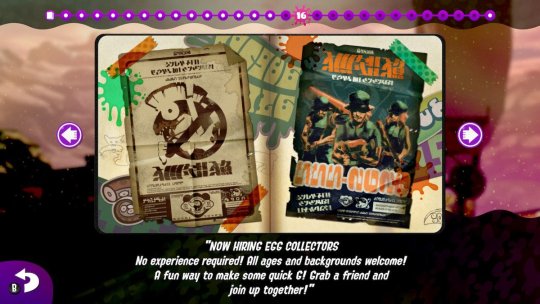
With the holidays in full swing, I took advantage of a deal one day when I went into town, and finally got my hands on Splatoon 2. Having loved the prior game as much as I did, waiting this long to get the sequel felt almost wrong. But like many another fellow meandering corpus of conscious flesh, I am made neither of time nor money.
Finally diving in, I figured I might take this excuse to remember that I write game reviews, sometimes. You know, when the tide is high, the moon blue, and the writer slightly less depressed. I ended up scrapping my first couple drafts, however. You see, a funny thing was happening; I kept veering back into talking about Salmon Run, the new optional game mode the sequel introduces.
Also I might look at the Octo Expansion later, on its own. After I get around to it…
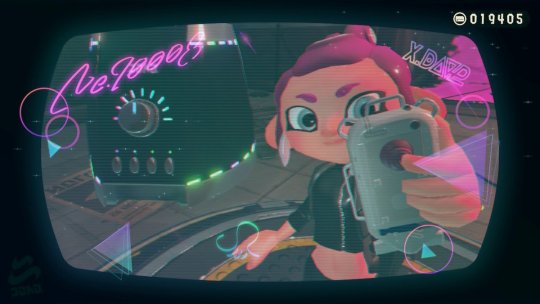
Look, the base game already has a lot of content to explore, and as previously stated, I am sadly corporeal, and not strung together with the metaphysical concept of time itself.
My overall thoughts, however, proved brief, so I’ll try to keep this short.
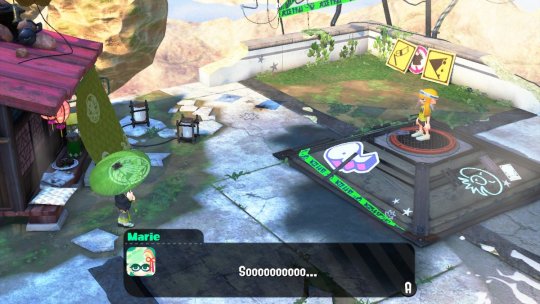
(Mild spoilers coming along.)
Gameplay wise, I think the story mode is much improved upon by handing you different weapons for certain levels which were specifically built with them in mind. Whereas the prior game left you stuck with a variant of the starter splattershot all the way through. This keeps things interesting, pushes me outside of my comfort zone, and it’s a good way to make sure players will come from a well-informed place when deciding what weapon they want for multiplayer; which, let’s face it, is the real meat of these games and where most players are going to log the most time.
I also love the way bosses are introduced with the heavy drums and rhythmic chants and the dramatic light show. It endows the moment with a fantastic sense of gravitas, and manages to hype me up every time. Then the boss will have an aspect of their design which feels a bit silly or some how rather off, keeping the overall tone heavily grounded in the toony aesthetics the series already established for itself.
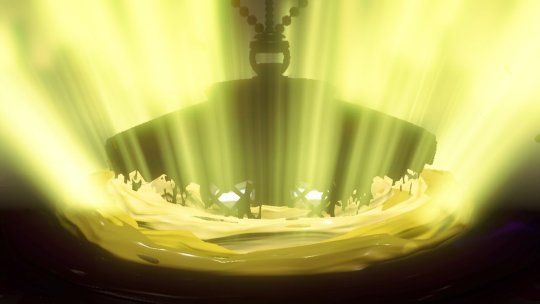
Narratively, I felt rather okay about the story aspect of Story Mode. The collectible pages in the levels still have a certain amount of world building, though this time it seems more skewed toward explaining what pop culture looks like in this world, such as, an allusion to this world’s equivalent to Instagram.
Cynical as it is…
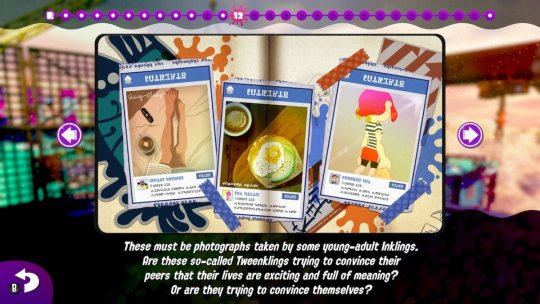
That’s definitely still interesting in its own right, though perhaps it’s less of a revelatory gut-punch as slowly piecing it together that the game takes place in the post-apocalypse of Earth itself, and the inklings copied ancient human culture.
We still got some backstory for this game’s idol duo, though. And that, I appreciate. It means Pearl and Marina still feel like a part of this world, rather than seeming obligatory for the sake of familiarity, given the first game had an idol duo as well.
Meanwhile, perhaps it is a bit obvious that Marie’s cousin, Callie, has gone rogue, and that she is the mysterious entity cracking into the radio transmissions between her and Agent 4. If I recall correctly, that was a working theory that came about with the first trailer or two. That, or she had died.
As soon as Marie says aloud she wonders where Callie has gone, I knew right away. And that’s just in the introduction.
That said, on some level, after stomaching through certain other games and such that actively lie or withhold information to force an arbitrary plot twist for plot twist sake, it feels almost nice to go back to a narrative that actually bothers to foreshadow these things. Plus, having gotten already invested in Callie as a character from the first game, I still felt motivated to see the story through to find out why she went rogue. And, loving the Squid Sisters already, there was a hope in me that she could be redeemed, or at least understood. In terms of building off the prior game’s story, Splatoon 2 is moderately decent.
Also, I mean, c’mon. The big narrative drive might be a tad predictable, but hey, this game is for kids. It’s fine.
That, I think, is something I love the most about Splatoon. Despite feeling like you’re playing in a Saturday morning cartoon, and being aimed primarily at children, it doesn’t shy away from fairly heavy subjects. Such as the aforementioned fact that the humans are all long dead and you’re basically playing paintball in the ruins of their consumerist culture.
Which brings me to what fascinates me so much about Splatoon 2: the way in which Salmon Run is framed.
You see, on the surface, Salmon Run appears to be your typical horde mode; a cooperative team (typically comprised of randoms) fights off gaggles of foes as they take turns approaching their base in waves. Pretty standard for online shooters these days, as was modernly popularized by Gears of War 2, and Halo ODST.
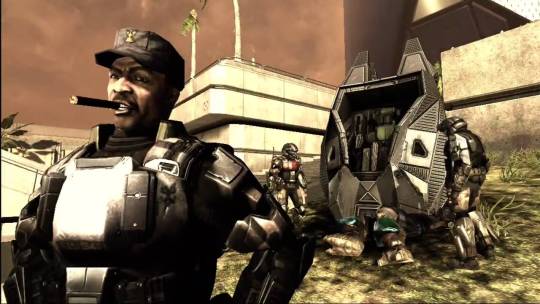
I say “modernly,” as the notion of fighting enemies as they approach in waves is not exactly a new concept for mechanical goals within video games. Rather, the term itself, as applied to multiplayer shooters, “horde mode,” became a point of game discussion when Gears of War 2 introduced the new game mode by that same name back in… 2008?
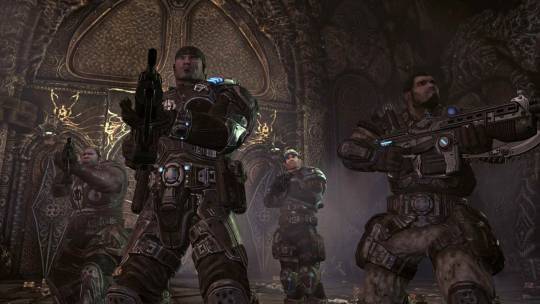
No, no that can’t be right. I played Gears 2 back in high school (I had worse taste back then, okay?). Which, from my perspective, was basically yesterday. That game being ten years old would mean I myself am old now, and that just can’t be. I’m hip. I’m young.
I am, to stay on theme here, fresh.
But okay, existential crises and game talk terms aside, the writing team behind Splatoon 2 probably decided to absolutely flex when it came to the narrative surrounding Salmon Run. It is one of the most gleaming examples of the nontraditional things you can do with writing in video games, to really elevate the experience.
Let me explain.
You see, narrative in video games typically falls into one of two categories: either the story sits comfortably inside of the game, utilizing it like a vehicle to arrive at the destination that is its audience’s waiting eyes and ears. Or the narrative, on some level, exists rather nebulously, primarily to provide something resembling context for why the pixels look the way they do, and why the goals are what they are.
Not to say this is a binary state of existence for game writing; narrative will of course always provide context for characters, should there be any. It’s primarily older, or retro games that give you a pamphlet or brief intro with little in the way of worrying over character motivation, and the deeper philosophical implications of the plot, etc (though not for lack of trying). These would be your classic Mario Bros. and what have you, where the actual game part of the video game is nearly all there is to explore in the overall experience.
Then you have games like Hotline Miami that purposely sets up shop right in the middle to make a meta commentary about the state of game narrative, using the ideological endpoint of violent 80’s era action and revenge-fantasy genre film as inspiration and the starting point to draw comparison between the two. It’s bizarre, and I could drone on about this topic.
But I digress.
Despite falling into that latter category, that is to say having mainly just an introduction to the narrative context so you can get on with playing the game, Salmon Run is a stellar example of how you can make every bit of that context count (even if it does require the added context of the rest of the game, sort of, which I’ll explain, trust me).
First, a (very) brief explanation of how the game itself works, for the maybe three of you who haven’t played it yet.
A team of up to four inklings (and/or octolings) have a small island out in open waters. Salmonid enemies storm the beaches from various angles in waves. Each wave also comes with (at least) one of eight unique boss variants, who all drop three golden eggs upon defeat. Players are tasked with gathering a number of said golden eggs each round, for three rounds, after which their failure or success in doing so shows slow or fast progress towards in-game rewards.
And it’s all an allegory for the poor treatment of labor/workers, utilizing the fishing industry as both an example and a thematically appropriate analogue. Yes, I’m serious.
First, Salmon Run is not available through the main doors like the other multiplayer modes. Rather, it is off to the side, down a dingy looking alley. And when you’re shown its location, either because you finally entered the Inkopolis plaza for the first time, or because the mode has entered rotation again, Marina very expressly describes it as a job.
A job you should only do if you are absolutely, desperately hard strapped for cash. You know, the sort of job you turn to if, for one reason or another, you can’t find a better one.
An aside: technically, playing Salmon Run does not automatically net you in-game currency, with which to buy things, as regular multiplayer modes do. Rather, your “pay” is a gauge you fill by playing, which comes with reward drops at certain thresholds; some randomized gacha style capsules, and one specific piece of gear which gets advertised, to incentivize playing.
The capsules themselves drop actual paychecks in the form of aforementioned currency, or meal tickets to get temporary buffs that help you progress in the multiplayer faster via one way or another. Which, hey, you know, that helps you earn more money also. Working to get “paid,” so you can get things you want, though, still works perfectly for the metaphor it creates.
When I first saw it open up for rotation, I found out you had to be at least a level four to participate. Pretty par for the course, considering it’s the same deal with the gear shops. But, again, it’s all in the presentation; Mr. Grizz does not simply say something akin to the usual “you must be this tall to ride.” He says he cannot hire inexperienced inklings such as yourself, because it’s a legal liability.
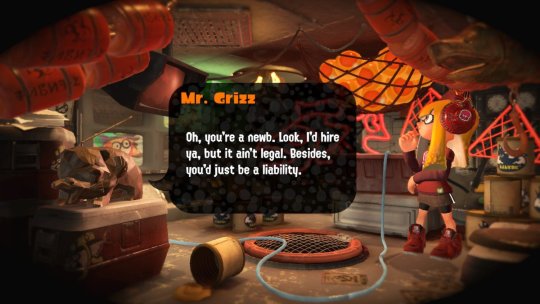
After returning with three extra levels, I was handed off to basic, on-the-job training. Which is only offered after Mr. Grizz (not ever physically present, mind you, but communicating with you via radio), the head of Grizzco, uses fairly typical hard sell rhetoric when it comes to dangerous, or otherwise undesirable work: calls you kid, talks about shaping the future and making the world a better place, refers to new hires as “fresh young talent,” says you’ll be “a part of something bigger than yourself.” You know, the usual balancing act of flattery, with just the right amount of belittlement.
Whoa, hang on, sorry; just had a bad case of deja vu from when the recruiter that worked with the ROTC back in high school tried to get me to enlist… several times… Guess he saw the hippie glasses and long hair and figured I'd be a gratifying challenge.
The fisher imagery really kicks in when you play. Which, I figure a dev team working out of Japan might have a pretty decent frame of reference for that. A boat whisks you out to sea with your team, and everyone’s given a matching uniform involving a bright orange jumper, and rubber boots and gloves. If you've ever seen the viral video of the fisherman up to his waist in water telling you not to give up, you have a rough idea. Oh, and don't forget your official Grizzco trademark hats.
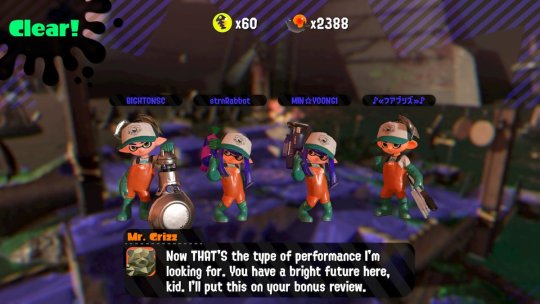
It’s on the job itself where a lot of what I'm talking about comes up the most; that is to say, despite buttering you up initially, Mr. Grizz shows his true colors pretty quickly. While playing, he seems to only be concerned with egg collecting, even when his employees are actively hurting. This is established and compounded by his dialogue prior to the intermediate training level, in which informs you about the various boss fish.
Before you can do anything remotely risky, even boss salmonid training, Mr. Grizz tells you he has to go over this 338 page workplace health and safety manual with you. But, oops, the new hire boat sounds the horn as you flip to page 1, so he sends you off unprepared. “Let’s just say you’ve read it,” he tells you, insisting that learning by doing is best.
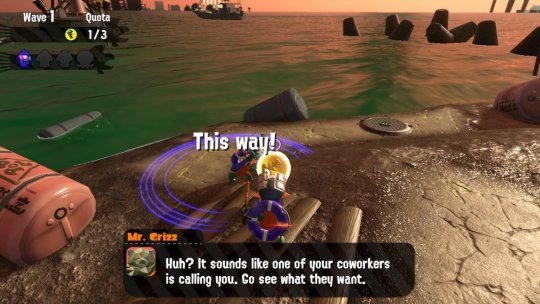
This flagrant disregard employee safety, in the name of met quotas; the fact we never see Mr. Grizz face to face, making him this vague presence that presides over you, evaluating your stressed performance with condescension; that we are not simply given the rewards as we pass thresholds to earn them, having to instead speak with another, unknown npc for our pay… It all drives toward the point so well.
The icing on the cake for me is when a match ends. You, the player, are not asked if you’d like to go back into matchmaking for another fun round of playtime. Rather, you are asked if you would like to “work another shift.”
The pieces all fit so well together. I shouldn’t be surprised that, once a theme is chosen, Splatoon can stick to it like my hand to rubber cement that one time. It has already proven it can do that much for sure. But it’s just so… funny? It’s bitterly, cynically hilarious.
Bless the individual(s) who sat in front of their keyboard, staring at the early script drafts, and asked aloud if they were really about to turn Mr. Grizz into a projection of all the worst aspects of the awful bosses they’ve had to deal with in life. The answer to that question being “yes” has led to some of my favorite writing in a video game.
All of these thoughts, as they started forming in my skull, really began to bubble when I noticed Salmon Run shifts become available during my first Splatfest.
Splatfest is, to try and put it in realistic terms, basically a huge, celebratory sporting event. Participation nets you a free commemorative t-shirt and access to a pumping concert featuring some of the hottest artists currently gracing the Inkopolis charts.
The idea, the notion, that a hip young inkling (or octoling) might miss out on one of the biggest parties of the year because they need money more than they need fun? It’s downright depressing.

It got me thinking. I looked at my fellow egg collectors. In-universe, we were a bunch of teen-to-young-adult aged denizens missing out on all the fun because we desperately needed the cash. We became stressed together, overworked together, yelled at by our boss together. But in those sweetest victories, where we’d far surpassed our quota? We celebrated together.
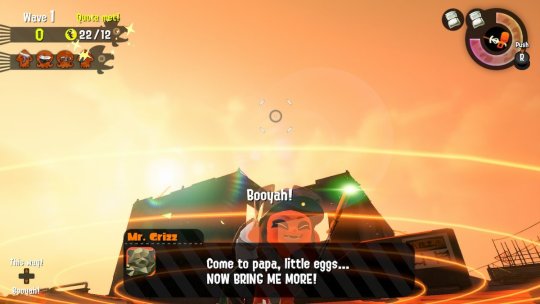
Spam-crouching, and mashing the taunt, something changed. I felt a greater sense of comradery with these squids and octos than I did in nearly any other coop game. And it’s all thanks to the rhetorical framing of the game mode.
It accomplishes so many things. It’s world building which wholistically immerses you in the setting. But mainly, its dedication to highly specific word choice does exactly what I mentioned earlier: it elevates the experience to one I could really sit down and think about, rather than use to while away the hours, then move on to something else. So many games make horde modes that feel inconsequential like that; it’s just for fun.
There’s nothing wrong with fun being the only mission statement for a game, or an optional mode of play. But this is exactly what I mean when I say this is the nontraditional writing games can do so much more with. And Splatoon 2 saw that opportunity, and took it. And what a fantastic example of bittersweet, cold reality, in this, a bright, colorful game meant mainly for children…
Happy Holidays, everyone!
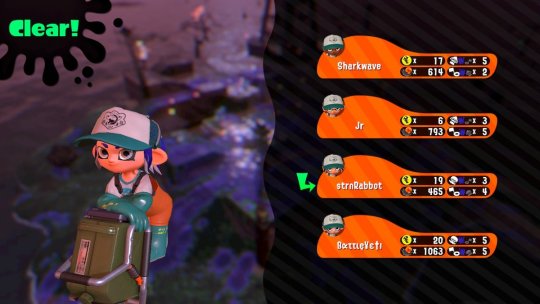
21 notes
·
View notes